A | Financial Statement Analysis
Financial statement analysis.
Financial statement analysis reviews financial information found on financial statements to make informed decisions about the business. The income statement, statement of retained earnings, balance sheet, and statement of cash flows, among other financial information, can be analyzed. The information obtained from this analysis can benefit decision-making for internal and external stakeholders and can give a company valuable information on overall performance and specific areas for improvement. The analysis can help them with budgeting, deciding where to cut costs, how to increase revenues, and future capital investments opportunities.
When considering the outcomes from analysis, it is important for a company to understand that data produced needs to be compared to others within industry and close competitors. The company should also consider their past experience and how it corresponds to current and future performance expectations. Three common analysis tools are used for decision-making; horizontal analysis, vertical analysis, and financial ratios.
For our discussion of financial statement analysis, we will use Banyan Goods. Banyan Goods is a merchandising company that sells a variety of products. The image below shows the comparative income statements and balance sheets for the past two years.
Keep in mind that the comparative income statements and balance sheets for Banyan Goods are simplified for our calculations and do not fully represent all the accounts a company could maintain. Let’s begin our analysis discussion by looking at horizontal analysis.

Horizontal Analysis
Horizontal analysis (also known as trend analysis) looks at trends over time on various financial statement line items. A company will look at one period (usually a year) and compare it to another period. For example, a company may compare sales from their current year to sales from the prior year. The trending of items on these financial statements can give a company valuable information on overall performance and specific areas for improvement. It is most valuable to do horizontal analysis for information over multiple periods to see how change is occurring for each line item. If multiple periods are not used, it can be difficult to identify a trend. The year being used for comparison purposes is called the base year (usually the prior period). The year of comparison for horizontal analysis is analyzed for dollar and percent changes against the base year.
The dollar change is found by taking the dollar amount in the base year and subtracting that from the year of analysis.
Using Banyan Goods as our example, if Banyan wanted to compare net sales in the current year (year of analysis) of $120,000 to the prior year (base year) of $100,000, the dollar change would be as follows:
The percentage change is found by taking the dollar change, dividing by the base year amount, and then multiplying by 100.
Let’s compute the percentage change for Banyan Goods’ net sales.
This means Banyan Goods saw an increase of $20,000 in net sales in the current year as compared to the prior year, which was a 20% increase. The same dollar change and percentage change calculations would be used for the income statement line items as well as the balance sheet line items. The image below shows the complete horizontal analysis of the income statement and balance sheet for Banyan Goods.
Depending on their expectations, Banyan Goods could make decisions to alter operations to produce expected outcomes. For example, Banyan saw a 50% accounts receivable increase from the prior year to the current year. If they were only expecting a 20% increase, they may need to explore this line item further to determine what caused this difference and how to correct it going forward. It could possibly be that they are extending credit more readily than anticipated or not collecting as rapidly on outstanding accounts receivable. The company will need to further examine this difference before deciding on a course of action. Another method of analysis Banyan might consider before making a decision is vertical analysis.
Vertical Analysis
Vertical analysis shows a comparison of a line item within a statement to another line item within that same statement. For example, a company may compare cash to total assets in the current year. This allows a company to see what percentage of cash (the comparison line item) makes up total assets (the other line item) during the period. This is different from horizontal analysis, which compares across years. Vertical analysis compares line items within a statement in the current year. This can help a business to know how much of one item is contributing to overall operations. For example, a company may want to know how much inventory contributes to total assets. They can then use this information to make business decisions such as preparing the budget, cutting costs, increasing revenues, or capital investments.
The company will need to determine which line item they are comparing all items to within that statement and then calculate the percentage makeup. These percentages are considered common-size because they make businesses within industry comparable by taking out fluctuations for size. It is typical for an income statement to use net sales (or sales) as the comparison line item. This means net sales will be set at 100% and all other line items within the income statement will represent a percentage of net sales.
On the balance sheet, a company will typically look at two areas: (1) total assets, and (2) total liabilities and stockholders’ equity. Total assets will be set at 100% and all assets will represent a percentage of total assets. Total liabilities and stockholders’ equity will also be set at 100% and all line items within liabilities and equity will be represented as a percentage of total liabilities and stockholders’ equity. The line item set at 100% is considered the base amount and the comparison line item is considered the comparison amount. The formula to determine the common-size percentage is:
For example, if Banyan Goods set total assets as the base amount and wanted to see what percentage of total assets were made up of cash in the current year, the following calculation would occur.
Cash in the current year is $110,000 and total assets equal $250,000, giving a common-size percentage of 44%. If the company had an expected cash balance of 40% of total assets, they would be exceeding expectations. This may not be enough of a difference to make a change, but if they notice this deviates from industry standards, they may need to make adjustments, such as reducing the amount of cash on hand to reinvest in the business. The image below shows the common-size calculations on the comparative income statements and comparative balance sheets for Banyan Goods.
Even though vertical analysis is a statement comparison within the same year, Banyan can use information from the prior year’s vertical analysis to make sure the business is operating as expected. For example, unearned revenues increased from the prior year to the current year and made up a larger portion of total liabilities and stockholders’ equity. This could be due to many factors, and Banyan Goods will need to examine this further to see why this change has occurred. Let’s turn to financial statement analysis using financial ratios.
Overview of Financial Ratios
Financial ratios help both internal and external users of information make informed decisions about a company. A stakeholder could be looking to invest, become a supplier, make a loan, or alter internal operations, among other things, based in part on the outcomes of ratio analysis. The information resulting from ratio analysis can be used to examine trends in performance, establish benchmarks for success, set budget expectations, and compare industry competitors. There are four main categories of ratios: liquidity, solvency, efficiency, and profitability. Note that while there are more ideal outcomes for some ratios, the industry in which the business operates can change the influence each of these outcomes has over stakeholder decisions. (You will learn more about ratios, industry standards, and ratio interpretation in advanced accounting courses.)
Liquidity Ratios
Liquidity ratios show the ability of the company to pay short-term obligations if they came due immediately with assets that can be quickly converted to cash. This is done by comparing current assets to current liabilities. Lenders, for example, may consider the outcomes of liquidity ratios when deciding whether to extend a loan to a company. A company would like to be liquid enough to manage any currently due obligations but not too liquid where they may not be effectively investing in growth opportunities. Three common liquidity measurements are working capital, current ratio, and quick ratio.
Working Capital
Working capital measures the financial health of an organization in the short-term by finding the difference between current assets and current liabilities. A company will need enough current assets to cover current liabilities; otherwise, they may not be able to continue operations in the future. Before a lender extends credit, they will review the working capital of the company to see if the company can meet their obligations. A larger difference signals that a company can cover their short-term debts and a lender may be more willing to extend the loan. On the other hand, too large of a difference may indicate that the company may not be correctly using their assets to grow the business. The formula for working capital is:
Using Banyan Goods, working capital is computed as follows for the current year:
In this case, current assets were $200,000, and current liabilities were $100,000. Current assets were far greater than current liabilities for Banyan Goods and they would easily be able to cover short-term debt.
The dollar value of the difference for working capital is limited given company size and scope. It is most useful to convert this information to a ratio to determine the company’s current financial health. This ratio is the current ratio.
Current Ratio
Working capital expressed as a ratio is the current ratio. The current ratio considers the amount of current assets available to cover current liabilities. The higher the current ratio, the more likely the company can cover its short-term debt. The formula for current ratio is:
The current ratio in the current year for Banyan Goods is:
A 2:1 ratio means the company has twice as many current assets as current liabilities; typically, this would be plenty to cover obligations. This may be an acceptable ratio for Banyan Goods, but if it is too high, they may want to consider using those assets in a different way to grow the company.
Quick Ratio
The quick ratio, also known as the acid-test ratio, is similar to the current ratio except current assets are more narrowly defined as the most liquid assets, which exclude inventory and prepaid expenses. The conversion of inventory and prepaid expenses to cash can sometimes take more time than the liquidation of other current assets. A company will want to know what they have on hand and can use quickly if an immediate obligation is due. The formula for the quick ratio is:
The quick ratio for Banyan Goods in the current year is:
A 1.6:1 ratio means the company has enough quick assets to cover current liabilities.
Another category of financial measurement uses solvency ratios.
Solvency Ratios
Solvency implies that a company can meet its long-term obligations and will likely stay in business in the future. To stay in business the company must generate more revenue than debt in the long-term. Meeting long-term obligations includes the ability to pay any interest incurred on long-term debt. Two main solvency ratios are the debt-to-equity ratio and the times interest earned ratio.
Debt to Equity Ratio
The debt-to-equity ratio shows the relationship between debt and equity as it relates to business financing. A company can take out loans, issue stock, and retain earnings to be used in future periods to keep operations running. It is less risky and less costly to use equity sources for financing as compared to debt resources. This is mainly due to interest expense repayment that a loan carries as opposed to equity, which does not have this requirement. Therefore, a company wants to know how much debt and equity contribute to its financing. Ideally, a company would prefer more equity than debt financing. The formula for the debt to equity ratio is:
The information needed to compute the debt-to-equity ratio for Banyan Goods in the current year can be found on the balance sheet.
This means that for every $1 of equity contributed toward financing, $1.50 is contributed from lenders. This would be a concern for Banyan Goods. This could be a red flag for potential investors that the company could be trending toward insolvency. Banyan Goods might want to get the ratio below 1:1 to improve their long-term business viability.
Times Interest Earned Ratio
Time interest earned measures the company’s ability to pay interest expense on long-term debt incurred. This ability to pay is determined by the available earnings before interest and taxes (EBIT) are deducted. These earnings are considered the operating income. Lenders will pay attention to this ratio before extending credit. The more times over a company can cover interest, the more likely a lender will extend long-term credit. The formula for times interest earned is:
The information needed to compute times interest earned for Banyan Goods in the current year can be found on the income statement.
The $43,000 is the operating income, representing earnings before interest and taxes. The 21.5 times outcome suggests that Banyan Goods can easily repay interest on an outstanding loan and creditors would have little risk that Banyan Goods would be unable to pay.
Another category of financial measurement uses efficiency ratios.
Efficiency Ratios
Efficiency shows how well a company uses and manages their assets. Areas of importance with efficiency are management of sales, accounts receivable, and inventory. A company that is efficient typically will be able to generate revenues quickly using the assets it acquires. Let’s examine four efficiency ratios: accounts receivable turnover, total asset turnover, inventory turnover, and days’ sales in inventory.
Accounts Receivable Turnover
Accounts receivable turnover measures how many times in a period (usually a year) a company will collect cash from accounts receivable. A higher number of times could mean cash is collected more quickly and that credit customers are of high quality. A higher number is usually preferable because the cash collected can be reinvested in the business at a quicker rate. A lower number of times could mean cash is collected slowly on these accounts and customers may not be properly qualified to accept the debt. The formula for accounts receivable turnover is:
Many companies do not split credit and cash sales, in which case net sales would be used to compute accounts receivable turnover. Average accounts receivable is found by dividing the sum of beginning and ending accounts receivable balances found on the balance sheet. The beginning accounts receivable balance in the current year is taken from the ending accounts receivable balance in the prior year.
When computing the accounts receivable turnover for Banyan Goods, let’s assume net credit sales make up $100,000 of the $120,000 of the net sales found on the income statement in the current year.
An accounts receivable turnover of four times per year may be low for Banyan Goods. Given this outcome, they may want to consider stricter credit lending practices to make sure credit customers are of a higher quality. They may also need to be more aggressive with collecting any outstanding accounts.
Total Asset Turnover
Total asset turnover measures the ability of a company to use their assets to generate revenues. A company would like to use as few assets as possible to generate the most net sales. Therefore, a higher total asset turnover means the company is using their assets very efficiently to produce net sales. The formula for total asset turnover is:
Average total assets are found by dividing the sum of beginning and ending total assets balances found on the balance sheet. The beginning total assets balance in the current year is taken from the ending total assets balance in the prior year.
Banyan Goods’ total asset turnover is:
The outcome of 0.53 means that for every $1 of assets, $0.53 of net sales are generated. Over time, Banyan Goods would like to see this turnover ratio increase.
Inventory Turnover
Inventory turnover measures how many times during the year a company has sold and replaced inventory. This can tell a company how well inventory is managed. A higher ratio is preferable; however, an extremely high turnover may mean that the company does not have enough inventory available to meet demand. A low turnover may mean the company has too much supply of inventory on hand. The formula for inventory turnover is:
Cost of goods sold for the current year is found on the income statement. Average inventory is found by dividing the sum of beginning and ending inventory balances found on the balance sheet. The beginning inventory balance in the current year is taken from the ending inventory balance in the prior year.
Banyan Goods’ inventory turnover is:
1.6 times is a very low turnover rate for Banyan Goods. This may mean the company is maintaining too high an inventory supply to meet a low demand from customers. They may want to decrease their on-hand inventory to free up more liquid assets to use in other ways.
Days’ Sales in Inventory
Days’ sales in inventory expresses the number of days it takes a company to turn inventory into sales. This assumes that no new purchase of inventory occurred within that time period. The fewer the number of days, the more quickly the company can sell its inventory. The higher the number of days, the longer it takes to sell its inventory. The formula for days’ sales in inventory is:
Banyan Goods’ days’ sales in inventory is:
243 days is a long time to sell inventory. While industry dictates what is an acceptable number of days to sell inventory, 243 days is unsustainable long-term. Banyan Goods will need to better manage their inventory and sales strategies to move inventory more quickly.
The last category of financial measurement examines profitability ratios.
Profitability Ratios
Profitability considers how well a company produces returns given their operational performance. The company needs to leverage its operations to increase profit. To assist with profit goal attainment, company revenues need to outweigh expenses. Let’s consider three profitability measurements and ratios: profit margin, return on total assets, and return on equity.
Profit Margin
Profit margin represents how much of sales revenue has translated into income. This ratio shows how much of each $1 of sales is returned as profit. The larger the ratio figure (the closer it gets to 1), the more of each sales dollar is returned as profit. The portion of the sales dollar not returned as profit goes toward expenses. The formula for profit margin is:
For Banyan Goods, the profit margin in the current year is:
This means that for every dollar of sales, $0.29 returns as profit. If Banyan Goods thinks this is too low, the company would try and find ways to reduce expenses and increase sales.
Return on Total Assets
The return on total assets measures the company’s ability to use its assets successfully to generate a profit. The higher the return (ratio outcome), the more profit is created from asset use. Average total assets are found by dividing the sum of beginning and ending total assets balances found on the balance sheet. The beginning total assets balance in the current year is taken from the ending total assets balance in the prior year. The formula for return on total assets is:
For Banyan Goods, the return on total assets for the current year is:
The higher the figure, the better the company is using its assets to create a profit. Industry standards can dictate what is an acceptable return.
Return on Equity
Return on equity measures the company’s ability to use its invested capital to generate income. The invested capital comes from stockholders investments in the company’s stock and its retained earnings and is leveraged to create profit. The higher the return, the better the company is doing at using its investments to yield a profit. The formula for return on equity is:
Average stockholders’ equity is found by dividing the sum of beginning and ending stockholders’ equity balances found on the balance sheet. The beginning stockholders’ equity balance in the current year is taken from the ending stockholders’ equity balance in the prior year. Keep in mind that the net income is calculated after preferred dividends have been paid.
For Banyan Goods, we will use the net income figure and assume no preferred dividends have been paid. The return on equity for the current year is:
The higher the figure, the better the company is using its investments to create a profit. Industry standards can dictate what is an acceptable return.
Advantages and Disadvantages of Financial Statement Analysis
There are several advantages and disadvantages to financial statement analysis. Financial statement analysis can show trends over time, which can be helpful in making future business decisions. Converting information to percentages or ratios eliminates some of the disparity between competitor sizes and operating abilities, making it easier for stakeholders to make informed decisions. It can assist with understanding the makeup of current operations within the business, and which shifts need to occur internally to increase productivity.
A stakeholder needs to keep in mind that past performance does not always dictate future performance. Attention must be given to possible economic influences that could skew the numbers being analyzed, such as inflation or a recession. Additionally, the way a company reports information within accounts may change over time. For example, where and when certain transactions are recorded may shift, which may not be readily evident in the financial statements.
A company that wants to budget properly, control costs, increase revenues, and make long-term expenditure decisions may want to use financial statement analysis to guide future operations. As long as the company understands the limitations of the information provided, financial statement analysis is a good tool to predict growth and company financial strength.
As an Amazon Associate we earn from qualifying purchases.
This book may not be used in the training of large language models or otherwise be ingested into large language models or generative AI offerings without OpenStax's permission.
Want to cite, share, or modify this book? This book uses the Creative Commons Attribution-NonCommercial-ShareAlike License and you must attribute OpenStax.
Access for free at https://openstax.org/books/principles-financial-accounting/pages/1-why-it-matters
- Authors: Mitchell Franklin, Patty Graybeal, Dixon Cooper
- Publisher/website: OpenStax
- Book title: Principles of Accounting, Volume 1: Financial Accounting
- Publication date: Apr 11, 2019
- Location: Houston, Texas
- Book URL: https://openstax.org/books/principles-financial-accounting/pages/1-why-it-matters
- Section URL: https://openstax.org/books/principles-financial-accounting/pages/a-financial-statement-analysis
© Dec 13, 2023 OpenStax. Textbook content produced by OpenStax is licensed under a Creative Commons Attribution-NonCommercial-ShareAlike License . The OpenStax name, OpenStax logo, OpenStax book covers, OpenStax CNX name, and OpenStax CNX logo are not subject to the Creative Commons license and may not be reproduced without the prior and express written consent of Rice University.

Financial Statement Analysis

Written by True Tamplin, BSc, CEPF®
Reviewed by subject matter experts.
Updated on June 08, 2023
Fact Checked
Why Trust Finance Strategists?
Table of Contents
What is financial statement analysis.
Financial statement analysis is one of the most fundamental practices in financial research and analysis.
In layman’s terms, it is the process of analyzing financial statements so that decision-makers have access to the right data.
Financial statement analysis is also used to take the pulse of a business. Since statements center on a company’s key financial details, they are useful for evaluating activities.
This is essential to understanding the firm’s overall performance.
What Are Financial Statements?
According to the American Institute of Public Accounts, financial statements are prepared for the following purposes:
- Presenting a periodical review or report on the progress made by the management
- Dealing with the status of investments in the business and the results achieved during the period under review
Financial statements reflect a combination of recorded facts, accounting conventions, and personal judgments.
The judgments and conventions that are applied are dependent on the competence and integrity of those who make them and on their adherence to generally accepted accounting principles (GAAP) and conventions.
Public companies are forced to keep track of their financial statements in very specific ways through a balance sheet, income statement, and cash flow statement.
However, private companies often underestimate the importance of these statements because they are not required to keep track of them. It’s not that they don’t create them, but they typically don’t use them to their full benefit.
Let’s consider the following important financial documents:
- Balance Sheet: Details a company’s value based on its assets , liabilities , and shareholder equity . We can learn a lot about the efficiency of a business’s operations from its short-term cash flow and accounts receivable.
- Income Statement: An income statement breaks down a company’s earnings by comparing expenses and revenue . It is broken down into separate categories that businesses can use to help them identify profitable areas.
- Cash Flow Statement : This report shows a company’s cash flow in terms of operational activities, financial ventures, and investments .
Tools and Techniques Used For Financial Statement Analysis
Financial statement analysis is centered on the balance sheet, income statement, and cash flow statement. It is the best way to gauge the overall health of a business.
There are several tools and techniques with which this is done, including:
- Fundamental Analysis: This analytical practice is used on a company’s most basic financial levels. It shows the health of the business on a financial level and helps provide insight into the overall value.
- DuPont Analysis: This tool is used to help companies prevent conclusions that are misleading. Sometimes, looking at sheer profitability doesn’t tell the whole story, so DuPont Analysis is used to create a detailed assessment.
- Horizontal Analysis: Here, we compare financial ratios, a specified benchmark, and a specified line item over a specific period. This allows firms to examine changes that have been made and compare them with other behaviors.
- Vertical Analysis: This financial analytical practice shows items within the financial statement as a percentage of the base figure. It’s simple, so it’s the method that most businesses prefer.
Value of Financial Statement Analysis When Analyzing and Reporting Financial Statements
Now that we’ve gone over some of the basics, let’s dive deeper into financial research and analysis. Here’s what makes financial statement analysis such a powerful tool.
Identifying the Industry’s Economic Characteristics
Financial statement analysis can identify several important factors in a business’s marketplace, sometimes finding smaller niches that are other methods miss.
We can use financial statement analysis to determine market size, compare competitors , and investigate the growth rate of a market as it relates to a variable such as spending.
It’s also possible to look beyond your own company and find out how others are faring in new markets before you decide to invest in them.
Another powerful tool that a lot of brands are using is product differentiation analysis. This method crunches financial numbers to see how well a brand’s products and prices are holding up against others in the same market.
There are several factors at play here, including distribution, purchasing, and advertising costs .
Identifying Company Strategies
All entrepreneurs understand the importance of finding the right strategy to meet the needs of their business. They spend a lot of time searching for the perfect one.
When you break it all down, the blueprint is usually the same, whether it’s developing a business plan or developing advanced strategies. That blueprint is defined by data.
The only difference between the two is that a business strategy is focused more on the future and the development of the business.
Once a strategy is established, then it has to be measured. The only true way to get accurate results is to compare financials.
Most strategies evolve, and financial analysis helps steer us in the right direction. For example, a detailed financial statement analysis will reveal the direction your company is moving. It will be the first indicator if growth is not where you want it to be.
Assessing the Quality of a Company’s Financial Statements
All businesses must have a method of efficiently analyzing their financial statements. This process requires three key points of understanding that must always be accounted for.
These can all be found through a sound financial statement analysis.
- Businesses must identify the economic characteristics of their industry and compare their finances to the average.
- Companies must be able to identify which strategies are profitable and which are not.
- Businesses must be able to gauge the quality of their financial statements.
Inaccurate financial statements are common in small businesses. If left unchecked, this will lead down a path of ruin.
Financial research and analysis are the best way to ensure that these valuable reports are steering your growth in the right direction.
Analyzing Profitability and Identifying Potential Business Risks
Every business strategy has risks, and the majority of those risks are felt on a financial level. Therefore, it’s important for businesses to devise ways to identify and mitigate these risks.
While it’s not possible to avoid every risk, we can identify them before they cause too much damage. This is done by keeping a close eye on profitability.
Noteworthily, then, financial statement analysis helps you to keep track of profitability ratios, enabling you to truly measure the overall value of a strategy moving forward.
Preparing Financial Statement Forecasts
Forecasts are how companies predict the direction in which their business is heading. These forecasts need to be aligned with the company’s overall goals.
Income , cash flow, and balance sheets must all be closely monitored to ensure that they are aligned with the organization’s overall growth objectives.
Financial statement analysis is the practice that the world’s leading businesses engage in to stay ahead of their competitors.
Financial Statement Analysis FAQs
What is financial statement analysis.
Financial Statement Analysis is the process of analyzing a company’s financial statements and using this information to gauge its performance over time, assess its current condition, and make predictions about future performance.
Why is Financial Statement Analysis important?
Financial Statement Analysis is an essential tool for investors and financial professionals as it can help them better understand a company’s financial health and improve their decision-making processes when making investments or loan decisions.
What types of Financial Statements are analyzed?
The three main financial statements used in Financial Statement Analysis are the Balance Sheet, Income Statement, and Cash Flow statement.
What analysis techniques are used to review Financial Statements?
Common analysis techniques used in Financial Statement Analysis include trend analysis, vertical and horizontal analyses, ratio analysis, and cash flow statement analysis.
What information can be gathered through Financial Statement Analysis?
Financial Statement Analysis can provide insights into a company’s financial position, performance over time, liquidity and solvency, profitability, the efficiency of operations, and more. It can also be used to assess the quality of accounting practices and risk levels.

About the Author
True Tamplin, BSc, CEPF®
True Tamplin is a published author, public speaker, CEO of UpDigital, and founder of Finance Strategists.
True is a Certified Educator in Personal Finance (CEPF®), author of The Handy Financial Ratios Guide , a member of the Society for Advancing Business Editing and Writing, contributes to his financial education site, Finance Strategists, and has spoken to various financial communities such as the CFA Institute, as well as university students like his Alma mater, Biola University , where he received a bachelor of science in business and data analytics.
To learn more about True, visit his personal website or view his author profiles on Amazon , Nasdaq and Forbes .
Related Topics
- Are Bonds Current Assets?
- Are Buildings Noncurrent Assets?
- Are Construction Works-In-Progress a Current Asset?
- Are Debt Investments Current Assets?
- Are Fixed Assets Current Assets?
- Are Intangible Assets Current Assets?
- Are Investments Current Assets?
- Are Marketable Securities Current Assets?
- Are Office Supplies a Current Asset?
- Are Supplies a Current Asset?
- Carrying Value or Book Value
- Chart of Accounts
- Combined Leverage
- Components of the Balance Sheet
- Creative Accounting
- Current Liabilities on the Balance Sheet
- Difference Between Trial Balance and Balance Sheet
- Effects of Transactions on a Balance Sheet
- Enterprise Value Formula & Calculation
- Financial Leverage
- Functions and Limitations of Balance Sheet
- Funds From Operations (FFO)
- Horizontal Analysis of Financial Statements
- Income Statement Analysis
- Indifference Analysis
- Is a Loan a Current Asset?
- Is a Patent a Noncurrent Asset?
- Is Accounts Payable a Current Asset?
- Is Accounts Receivable a Current Asset?
- Is Accounts Receivable a Material Component of a Company’s Total Current Assets?
Ask a Financial Professional Any Question
We use cookies to ensure that we give you the best experience on our website. If you continue to use this site we will assume that you are happy with it.
At Finance Strategists, we partner with financial experts to ensure the accuracy of our financial content.
Our team of reviewers are established professionals with decades of experience in areas of personal finance and hold many advanced degrees and certifications.
They regularly contribute to top tier financial publications, such as The Wall Street Journal, U.S. News & World Report, Reuters, Morning Star, Yahoo Finance, Bloomberg, Marketwatch, Investopedia, TheStreet.com, Motley Fool, CNBC, and many others.
This team of experts helps Finance Strategists maintain the highest level of accuracy and professionalism possible.
Why You Can Trust Finance Strategists
Finance Strategists is a leading financial education organization that connects people with financial professionals, priding itself on providing accurate and reliable financial information to millions of readers each year.
We follow strict ethical journalism practices, which includes presenting unbiased information and citing reliable, attributed resources.
Our goal is to deliver the most understandable and comprehensive explanations of financial topics using simple writing complemented by helpful graphics and animation videos.
Our writing and editorial staff are a team of experts holding advanced financial designations and have written for most major financial media publications. Our work has been directly cited by organizations including Entrepreneur, Business Insider, Investopedia, Forbes, CNBC, and many others.
Our mission is to empower readers with the most factual and reliable financial information possible to help them make informed decisions for their individual needs.
How It Works
Step 1 of 3, ask any financial question.
Ask a question about your financial situation providing as much detail as possible. Your information is kept secure and not shared unless you specify.

Step 2 of 3
Our team will connect you with a vetted, trusted professional.
Someone on our team will connect you with a financial professional in our network holding the correct designation and expertise.

Step 3 of 3
Get your questions answered and book a free call if necessary.
A financial professional will offer guidance based on the information provided and offer a no-obligation call to better understand your situation.

Where Should We Send Your Answer?

Just a Few More Details
We need just a bit more info from you to direct your question to the right person.
Tell Us More About Yourself
Is there any other context you can provide.
Pro tip: Professionals are more likely to answer questions when background and context is given. The more details you provide, the faster and more thorough reply you'll receive.
What is your age?
Are you married, do you own your home.
- Owned outright
- Owned with a mortgage
Do you have any children under 18?
- Yes, 3 or more
What is the approximate value of your cash savings and other investments?
- $50k - $250k
- $250k - $1m
Pro tip: A portfolio often becomes more complicated when it has more investable assets. Please answer this question to help us connect you with the right professional.
Would you prefer to work with a financial professional remotely or in-person?
- I would prefer remote (video call, etc.)
- I would prefer in-person
- I don't mind, either are fine
What's your zip code?
- I'm not in the U.S.
Submit to get your question answered.
A financial professional will be in touch to help you shortly.

Part 1: Tell Us More About Yourself
Do you own a business, which activity is most important to you during retirement.
- Giving back / charity
- Spending time with family and friends
- Pursuing hobbies
Part 2: Your Current Nest Egg
Part 3: confidence going into retirement, how comfortable are you with investing.
- Very comfortable
- Somewhat comfortable
- Not comfortable at all
How confident are you in your long term financial plan?
- Very confident
- Somewhat confident
- Not confident / I don't have a plan
What is your risk tolerance?
How much are you saving for retirement each month.
- None currently
- Minimal: $50 - $200
- Steady Saver: $200 - $500
- Serious Planner: $500 - $1,000
- Aggressive Saver: $1,000+
How much will you need each month during retirement?
- Bare Necessities: $1,500 - $2,500
- Moderate Comfort: $2,500 - $3,500
- Comfortable Lifestyle: $3,500 - $5,500
- Affluent Living: $5,500 - $8,000
- Luxury Lifestyle: $8,000+
Part 4: Getting Your Retirement Ready
What is your current financial priority.
- Getting out of debt
- Growing my wealth
- Protecting my wealth
Do you already work with a financial advisor?
Which of these is most important for your financial advisor to have.
- Tax planning expertise
- Investment management expertise
- Estate planning expertise
- None of the above
Where should we send your answer?
Submit to get your retirement-readiness report., get in touch with, great the financial professional will get back to you soon., where should we send the downloadable file, great hit “submit” and an advisor will send you the guide shortly., create a free account and ask any financial question, learn at your own pace with our free courses.
Take self-paced courses to master the fundamentals of finance and connect with like-minded individuals.
Get Started
Hey, did we answer your financial question.
We want to make sure that all of our readers get their questions answered.
Great, Want to Test Your Knowledge of This Lesson?
Create an Account to Test Your Knowledge of This Topic and Thousands of Others.
Get Your Question Answered by a Financial Professional
Create a free account and submit your question. We'll make sure a financial professional gets back to you shortly.

Introduction to Financial Analysis
(0 reviews)
Kenneth S. Bigel, New York City, New York
Copyright Year: 2022
Publisher: Open Touro
Language: English
Formats Available
Conditions of use.
Table of Contents
- About the Author
- Author's Acknowledgements
- Open Touro Acknowledgements
- Chapter 1: Introduction
- Chapter 2: Financial Statement Analysis: The Balance Sheet
- Chapter 3: Financial Statements Analysis: The Income Statement
- Chapter 4: Financial Statements and Finance
- Chapter 5: Financial Ratios and Forecasting; Liquidity and Solvency Ratios
- Chapter 6: Profitability and Return Ratios, and Turnover
- Chapter 7: Market Ratios
- Chapter 8: Cash Flow, Depreciation, and Financial Projections
- Chapter 9: Corporate Forecasting Models
- Chapter 10: The Time Value of Money: Simple Present- and Future-Values
- Chapter 11: The Time Value of Money: Annuities, Perpetuities, and Mortgages
- Chapter 12: Fixed Income Valuation
- Chapter 13: Interest Rates
- Chapter 14: Equity Valuation and Return Measurement
Ancillary Material
About the book.
This Open Textbook is a dynamic guide incorporating the essential skills needed to build a foundation in Financial Analysis . Students and readers will learn how to insightfully read a Financial Statement, utilize key financial ratios in order to derive forward-looking investment-related inferences from the accounting data, engage in elementary forecasting and modeling, master the theory of the Time Value of Money , and learn to price stocks and bonds in an environment in which interest rates constantly change. Ample problems and solutions, and review questions are provided to the student so that s/he can gauge his/her progress. This text will be continually updated in order to provide novel information and enhance students’ experiences.
About the Contributors
Dr. Bigel was formerly a fixed income analyst in the International Banking Department of the Bankers Trust Company (now DeutscheBank), analyzing international wholesale loans and debt instruments, and a graduate of its Institutional Credit Training Program. He later was affiliated with the Ford Motor Company, conducting investment analysis and planned car profits analysis, annual budgeting, and strategic planning. Subsequently, he worked as a senior portfolio manager attached to the wealth management division of Prudential Securities. He was formerly registered under Series 3, 7, 15, 24, 63, and 65.
As an independent consultant, he was involved in numerous high-profile cases including Enron. Dr. Bigel has conducted executive education programs for Morgan Stanley Capital Markets, Merrill Lynch Capital Markets, UBS, Lehman Brothers, CIBC, G.X. Clarke & Co. (now part of Goldman Sachs), and China CITIC Bank. He currently serves on the Financial Industry Regulatory Association’s Board of Arbitrators.
His extensive published research relates to Financial Ethics and Moral Development, Behavioral Finance, and Political Economy. He has been teaching college and graduate level finance courses since 1989.
Dr. Bigel has been interviewed on American radio, was a visiting scholar at Sichuan University and at Xi’an Jiaotong University in China, and appeared on Chinese television. At Touro University, he is a member of the Faculty Senate, The Touro Academy of Leadership and Management, The Assessments Committee, and The Promotions Committee. He chairs the Integrity Committee at LCM.
His wife and their three children reside in New York City. He enjoys reading, playing 60’s guitar, seeing his students succeed professionally, and watching his kids grow.
Educational Background:
- Ph.D., (high honors) New York University, Steinhardt School of Culture, Education, and Human Development (Business Education and Financial Ethics)
- M.B.A., New York University, Stern School of Business (Finance)
- B.A. (honors), Brooklyn College of the City University of New York (Philosophy and Mathematics)
- CFP™, International Board of Standards and Practices for Certified Financial Planners
- Hebrew University of Jerusalem (one-year program)
Dr. Bigel welcomes questions and constructive suggestions. He can be reached at <[email protected]>.
Contribute to this Page

- school Campus Bookshelves
- menu_book Bookshelves
- perm_media Learning Objects
- login Login
- how_to_reg Request Instructor Account
- hub Instructor Commons
- Download Page (PDF)
- Download Full Book (PDF)
- Periodic Table
- Physics Constants
- Scientific Calculator
- Reference & Cite
- Tools expand_more
- Readability
selected template will load here
This action is not available.

7.3: Financial Statement Analysis
- Last updated
- Save as PDF
- Page ID 43113
At this point, you have learned quite a bit about financial accounting. This includes the process of analyzing a wide variety of transactions, recording them in the journal, maintaining running account balances, and summarizing theinformation in the financial statements.
Businesses publish financial statements to communicate information about their operating performance and economic health. The income statement shows the profitability of a business by presenting its revenue and expenses for a period of time and summarizes its profitability in one final result: net income. The retained earnings statement reports all of the profit that a business has accumulated since it began operations. The balance sheet is a comprehensive summary report that lists a business’s assets, liabilities, owner investments, and accumulated profit. Examples of basic financial statements appear below.
Once the financial statements are available, the next step is to analyze them to gleen useful information about a corporation’s performance over time and its current financial health. These insights help business managers and investors make decisions about future courses of action. Areas of weakness may be identified and followed up with appropriate measures for improvement. Elements of strength should be reinforced and continued.
Much of this financial statement analysis is accomplished using ratios that reveal how one amount relates to another. One or more amounts are divided by other amount(s), yielding a decimal or percentage amount. However, no ratio is particularly meaningful by itself; it needs to be compared to something else, such as desired or expected results, previous results, other companies’ results, or industry standards. This comparison lets you know where you stand in terms of whether you are doing better, worse, or the same as what you have expected or hoped for.

ANNUAL CHECK-UP
Many people visit a doctor annually for a check-up to evaluate their overall health. This often involves a physician looking, listening, poking, prodding, weighing, and conducting tests to assess the strength and wellness of multiple body parts and the status of vital signs and chemical levels.
The results may be positive in some areas and less so in others. One deficiency or ailment may impact the body as a whole. As weaknesses are uncovered, measures such as medication, procedures, exercise, diet changes, etc. may be prescribed to assist with recovery.
For example, if high cholesterol levels and excessive weight are discovered, lifestyle changes and medication may be recommended. At the following year’s visit, subsequent testing will reveal the progress made over time in these areas as well as other diagnostic results on that particular date. The goal is to continuously address deficiencies for improvement and to maintain positive outcomes on an ongoing basis.
A similar process is used for determining the operational and financial health of a corporation. The financial statements represent the current condition of an organization as a whole for a period of time. Probing, testing, and spot-checking efforts are conducted on a number of its parts to verify areas of strength and to pinpoint weaknesses. Action plans for improvement may then be prescribed to address substandard line items going forward.
7.3.1 Horizontal analysis
Important information can result from looking at changes in the same financial statement over time, both in terms of dollar amounts and percentage differences. Comparative financial statements place two years (or more) of the same statement side by side. A horizontal analysis involves noting the increases and decreases both in the amount and in the percentage of each line item. The earlier year is typically used as the base year for calculating increases or decreases in amounts.

A horizontal analysis of a firm’s 2018 and 2019 income statements appears to the left. The first two columns show income statement amounts for two consecutive years. The amount and percentage differences for each line are listed in the final two columns, respectively.
The presentation of the changes from year to year for each line item can be analyzed to see where positive progress is occuring over time, such as increases in revenue and profit and decreases in cost. Conversely, less favorable readings may be isolated using this approach and investigated further.
In this sample comparative income statement, sales increased 20.0% from one year to the next, yet gross profit and income from operations increased quite a bit more at 33.3% and 60.0%, respectively. However, the final net incomeamount increased only 7.4%. Changes between the income from operations and net income lines can be reviewed to identify the reasons for the relatively lower increase in net income.
Likewise, the following is a horizontal analysis of a firm’s 2018 and 2019 balance sheets. Again, the amount and percentage differences for each line are listed in the final two columns, respectively.
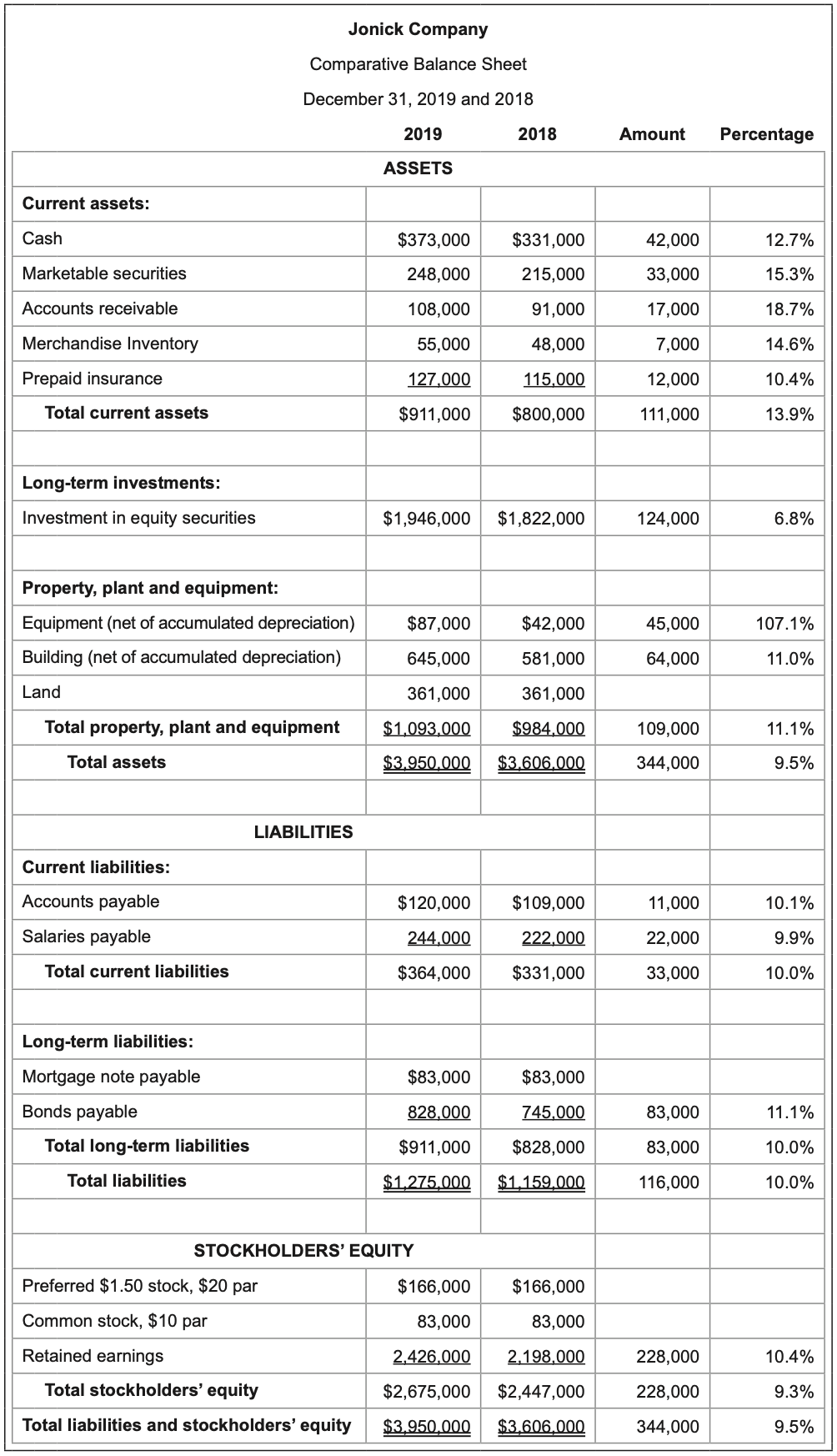
The horizontal analysis to the left uses a firm’s 2018 and 2019 balance sheets. Again, the amount and percentage differences for each line are listed in the final two columns, respectively.
The increase of $344,000 in total assets represents a 9.5% change in the positive direction. Total liabilities increased by 10.0%, or $116,000, from year to year. The change in total stockholders’ equity of $228,000 is a 9.3% increase. There seems to be a relatively consistent overall increase throughout the key totals on the balance sheet.
7.3.2 Vertical Analysis
A vertical analysis may also be conducted to each financial statement to report the percentage of each line item to a total amount.
On the comparative income statement, the amount of each line item is divided by the sales number, which is the largest value.

On the comparative balance sheet, the amount of each line item is divided by the total assets amount, which is the largest value (and which equals total liabilities and stockholders’ equity.)

On both financial statements, percentages are presented for two consecutive years so that the percent changes over time may be evaluated.
7.3.3 Common-size Statements
The use of percentages converts a company’s dollar amounts on its financial statements into values that can be compared to other companies whose dollar amounts may be different.
Common-size statements include only the percentages that appear in either a horizontal or vertical analysis. They often are used to compare one company to another or to compare a company to other standards, such as industry averages.
The following compares the performance of two companies using a vertical analysis on their income statements for 2019.
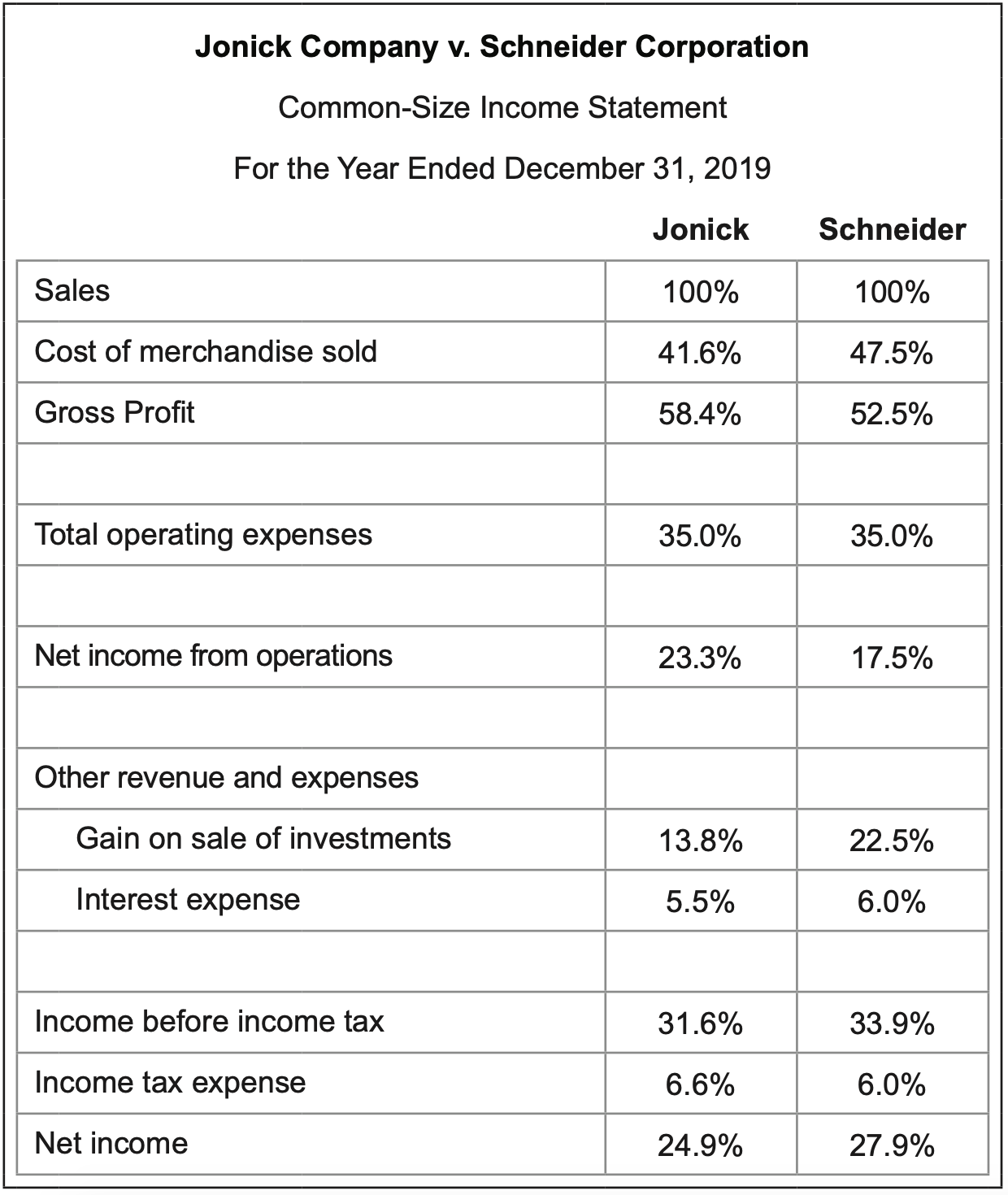
7.3.4 Ratio Analysis
Horizontal and vertical analyses present data about each line item on the financial statements in a uniform way across the board. Additional insight about a corporation’s financial performance and health can be revealed by calculating targeted ratios that use specific amounts that relate to one another. Again, as stated earlier, no ratio is meaningful by itself; it needs to be compared to something, such as desired or expected results, previous results, other companies’ results, or industry standards.
There are a series of ratios that are commonly used by corporations. These will be classified as liquidity, solvency, profitability, and return on investment.
Liquidity analysis looks at a company’s available cash and its ability to quickly convert other current assets into cash to meet short-term operating needs such as paying expenses and debts as they become due. Cash is the most liquid asset; other current assets such as accounts receivable and inventory may also generate cash in the near future.
Creditors and investors often use liquidity ratios to gauge how well a business is performing. Since creditors are primarily concerned with a company’s ability to repay its debts, they want to see if there is enough cash and equivalents available to meet the current portions of debt.
Six liquidity ratios follow. The current and quick ratios evaluate a company’s ability to pay its current liabilities. Accounts receivable turnover and number of days’ sales in receivables look at the firm’s ability to collect its accounts receivable. Inventory turnover and number of days’ sales in inventory gauge how effectively a company manages its inventory.
CURRENT RATIO
What it measures: The ability of a firm to pay its current liabilities with its cash and/or other current assets that can be converted to cash within a relatively short period of time.
\(\ \text{Calculation:} \frac{\text { Current assets }}{\text { Current liabilities }}=\frac{911,000}{364,000}=2.5\)
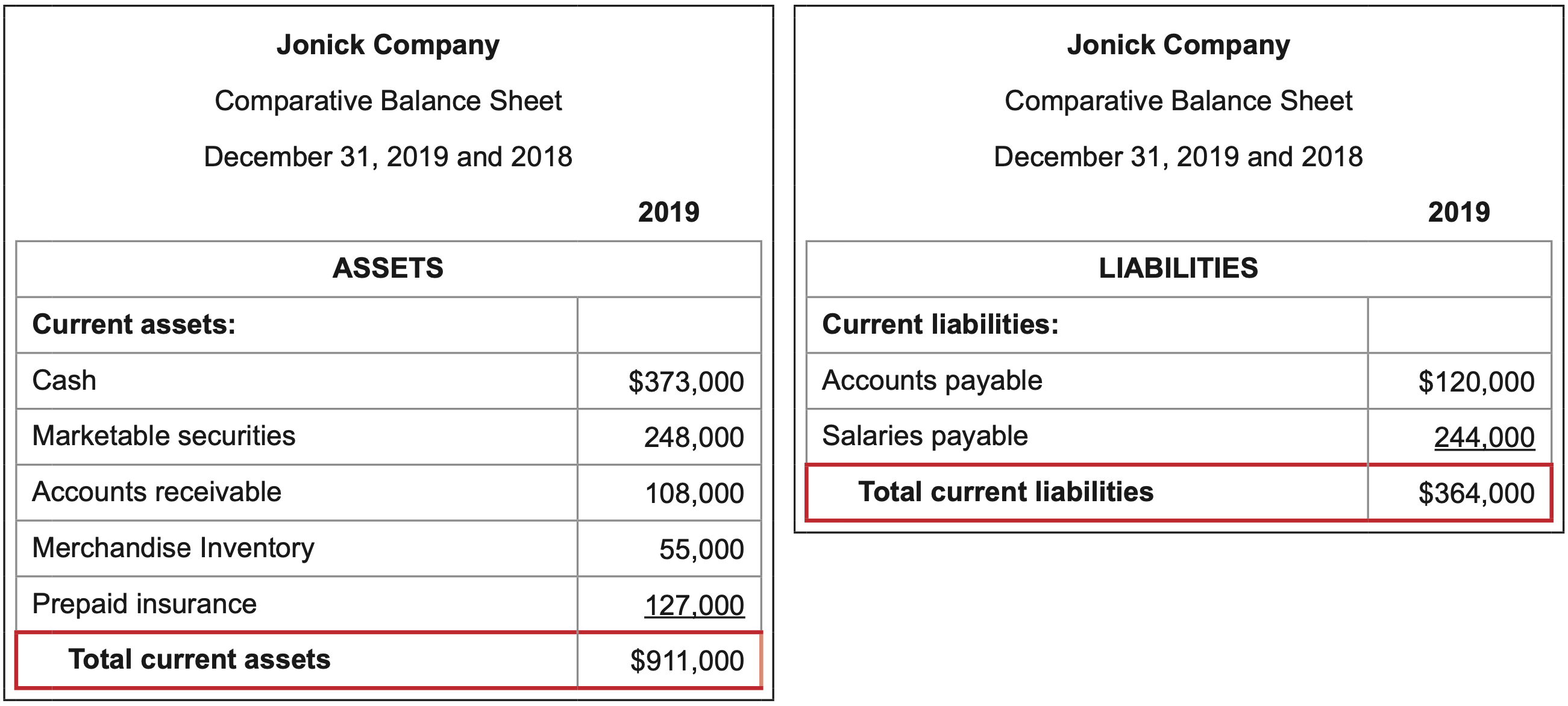
Interpretation : This company has 2.5 times more in current assets than it has in current liabilities. The premise is that current assets are liquid; that is, they can be converted to cash in a relatively short period of time to cover short-term debt. A current ratio is judged as satisfactory on a relative basis. If the company prefers to have a lot of debt and not use its own money, it may consider 2.5 to be too high – too little debt for the amount of assets it has. If a company is conservative in terms of debt and wants to have as little as possible, 2.5 may be considered low – too little asset value for the amount of liabilities it has. For an average tolerance for debt, a current ratio of 2.5 may be considered satisfactory. The point is that whether the current ratio is considered acceptable is subjective and will vary from company to company.
QUICK RATIO
What it measures: the ability of a firm to pay its current liabilities with its cash and other current assets that can be converted to cash within an extremely short period of time . Quick assets include cash, accounts receivable, and marketable securities but do not include inventory or prepaid items.
\(\ \text{Calculation:} \frac{\text { Quick assets }}{\text { Current liabilities }}=\frac{373,000+248,000+108,000}{364,000}=2.0\)
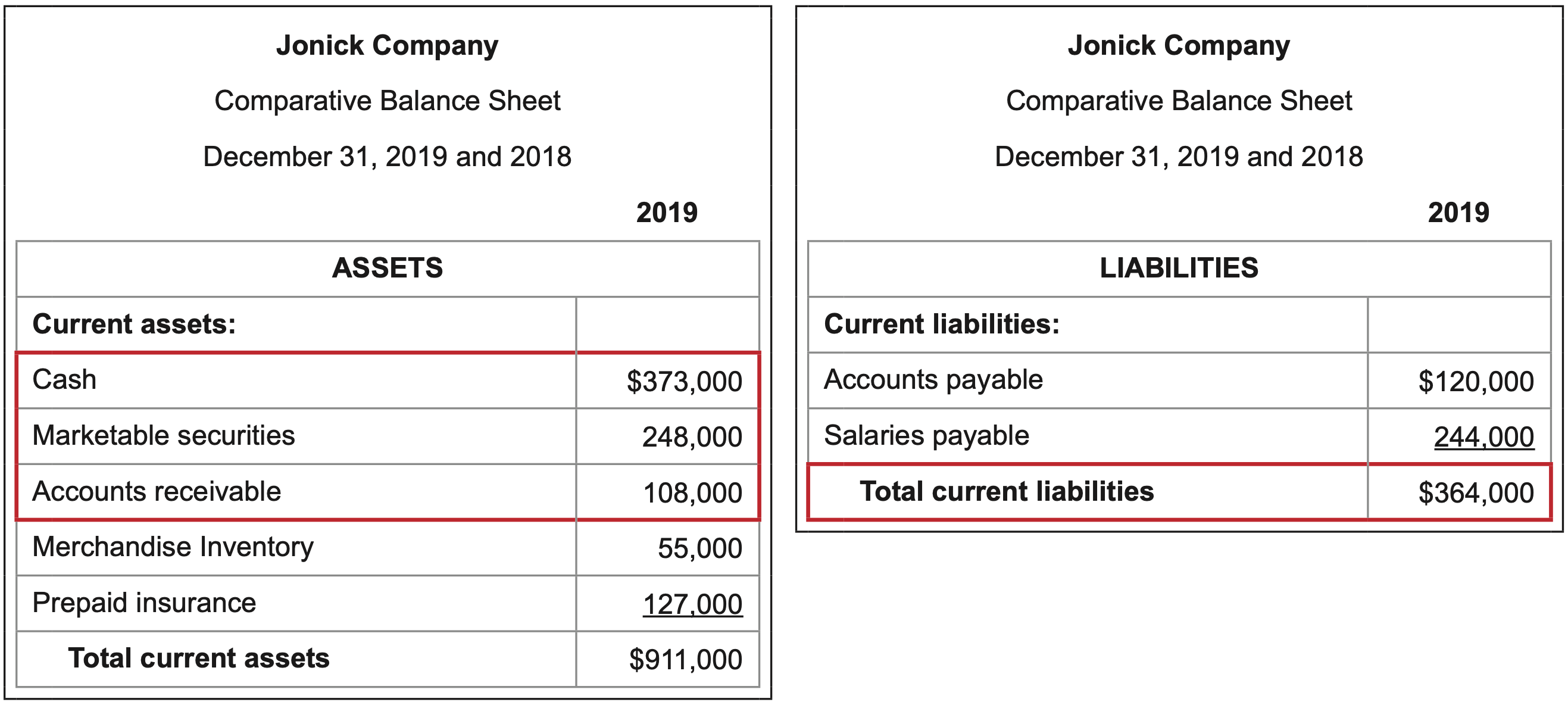
Interpretation: This company has 2.0 times more in its highly liquid current assets, which include cash, marketable securities, and accounts receivable, than it has in current liabilities. The premise is these current assets are the most liquid and can be immediately converted to cash to cover short-term debt. Current assets such as inventory and prepaid items would take too long to sell to be considered quick assets. A quick ratio is judged as satisfactory on a relative basis. If the company prefers to have a lot of debt and not use its own money, it may consider 2.0 to be too high – too little debt for the amount of assets it has. If a company is conservative in terms of debt and wants to have as little as possible, 2.0 may be considered low – too little asset value for the amount of liabilities it has. For an average tolerance for debt, a current ratio of 2.0 may be considered satisfactory. The point is that whether the quick ratio is considered acceptable is subjective and will vary from company to company.
ACCOUNTS RECEIVABLE TURNOVER
What it measures: the number of times the entire amount of a firm’s accounts receivable, which is the monies owed to the company by its customers, is collected in a year.
\(\ \text{Calculation:} \frac{\text { Sales }}{\text { Average accounts receivable }}=\frac{994,000}{(108,000 + 91,000)/2}=10.0\)
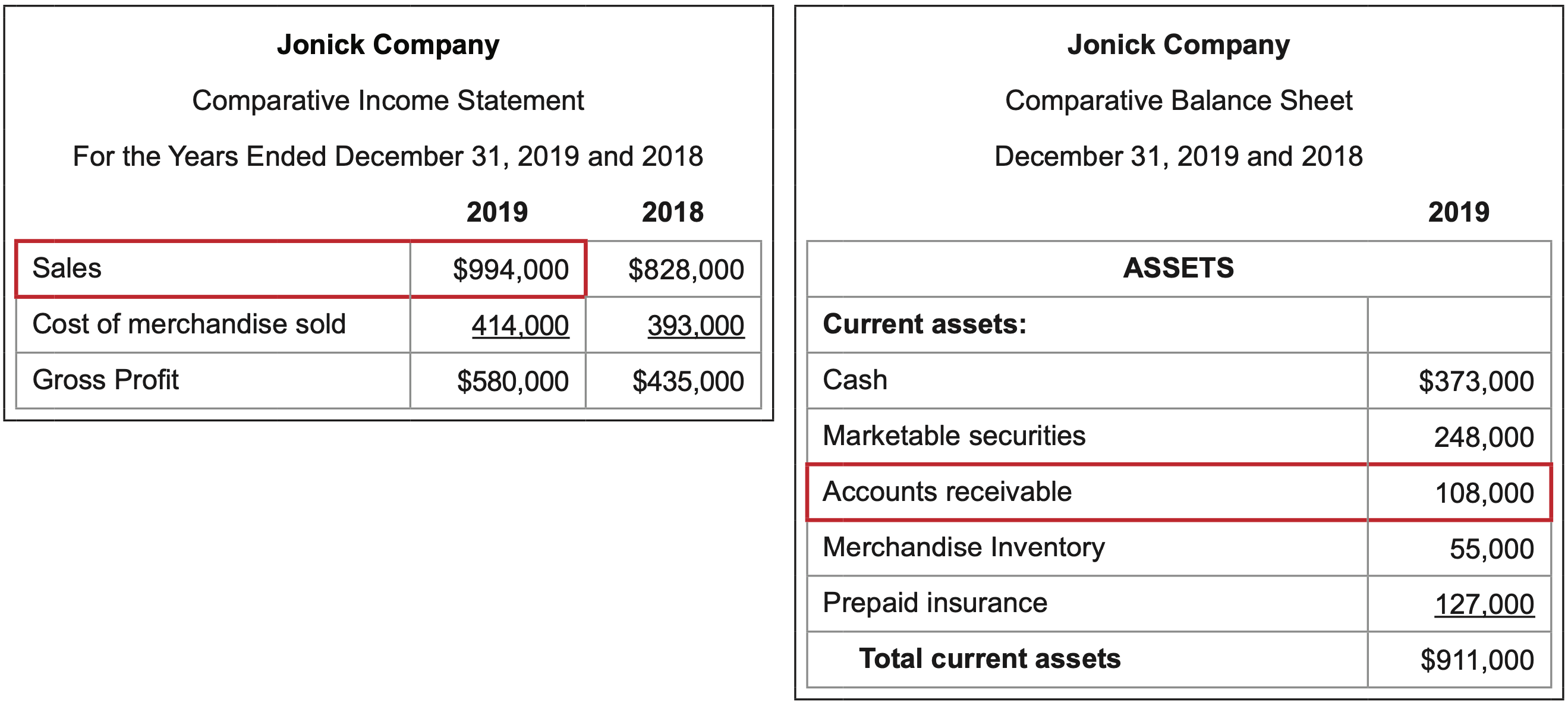
Interpretation: The higher the better. The more often customers pay off their invoices, the more cash available to the firm to pay bills and debts and less possibility that customers will never pay at all.
NUMBER OF DAYS’ SALES IN RECEIVABLES
What it measures: the number of days it typically takes for customers to pay on account.
\(\ \text{Calculation:} \frac{\text { Average accounts receivable }}{\text { Sales / } 365}=\frac{(108,000+91,000) / 2}{994,000 / 365}=36.5 days\)
The denominator of “Sales / 365” represents the dollar amount of sales per day in a 365-day year.

Interpretation: The lower the better. The less time it takes customers to pay off their invoices, the more cash available to the firm to pay bills and debts and less possibility that customers will never pay at all.
INVENTORY TURNOVER
What it measures: the number of times the average amount of a firm’s inventory is sold in a year.
\(\ \text{Calculation:} \frac{\text { Cost of merchandise sold }}{\text { Average inventory }}=\frac{414,000}{(55,000 + 48,000)/2}=8.0\)
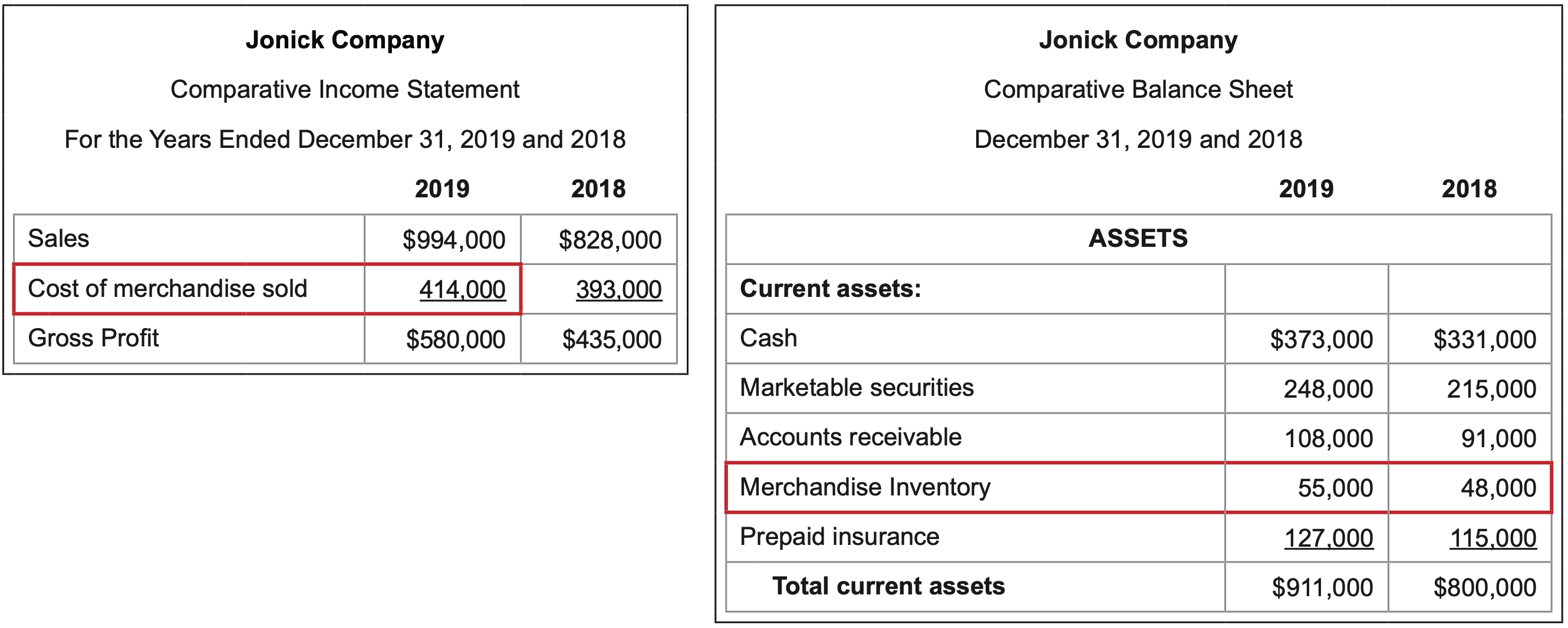
Interpretation: The higher the better. The more often inventory is sold, the more cash generated by the firm to pay bills and debts. Inventory turnover is also a measure of a firm’s operational performance. If the company’s line of business is to sell merchandise, the more often it does so, the more operationally successful it is.
NUMBER OF DAYS’ SALES IN INVENTORY
What it measures: the number of days it typically takes for a typical batch of inventory to be sold.
\(\ \text{Calculation}: \frac{\text {Average inventory }}{\text { Cost of merchandise sold/365 }}=\frac{(55,000 + 48,000)/2}{(414,000/365)}=45.4 \text{ days}\)
The denominator of “Cost of merchandise sold / 365” represents the dollar amount of cost per day in a 365-day year.
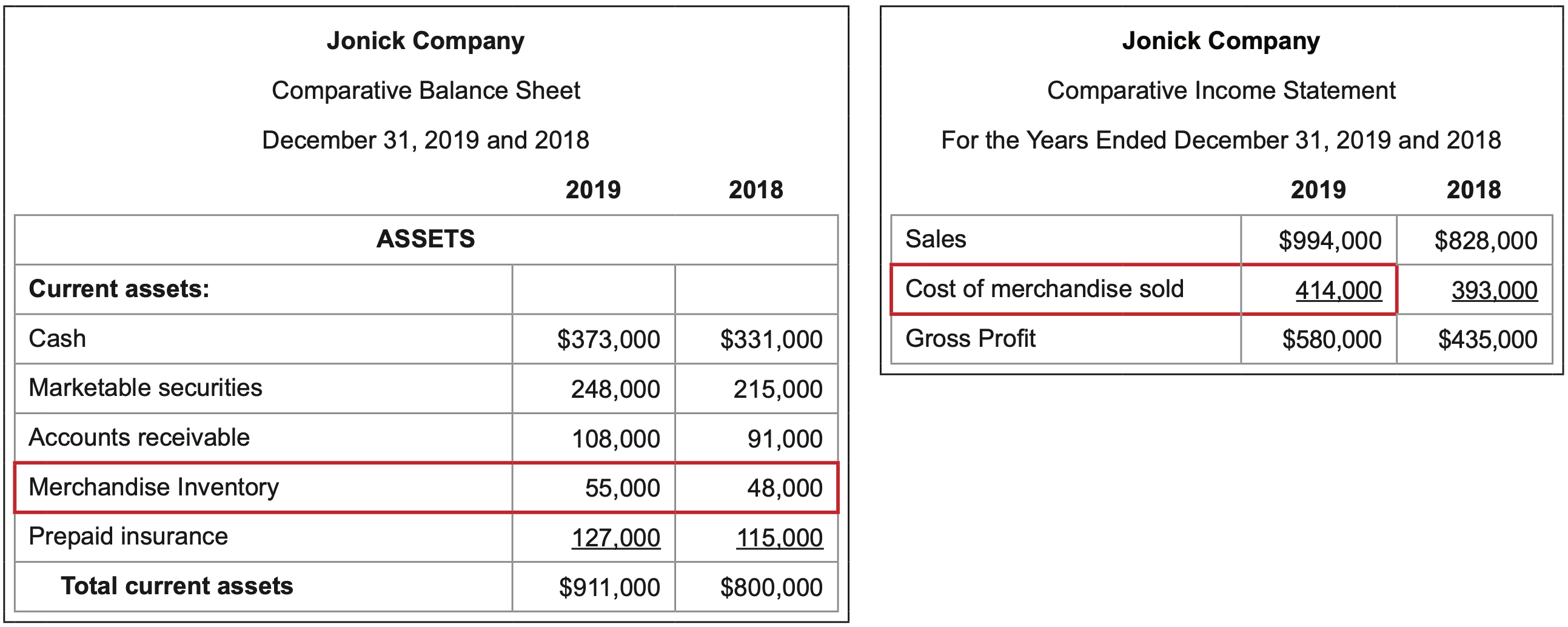
Interpretation: The lower the better. The less time it takes for the inventory in stock to be sold, the more cash available to the firm to pay bills and debts. There is also less of a need to pay storage, insurance, and other holding costs and less of a chance that inventory on hand will become outdated and less attractive to customers.
Solvency analysis evaluates a company’s future financial stability by looking at its ability to pay its long-term debts.
Both investors and creditors are interested in the solvency of a company. Investors want to make sure the company is in a strong financial position and can continue to grow, generate profits, distribute dividends, and provide a return on investment. Creditors are concerned with being repaid and look to see that a company can generate sufficient revenues to cover both short and long-term obligations.
Four solvency ratios follow.
RATIO OF LIABILITIES TO STOCKHOLDERS’ EQUITY
What it measures: the ability of a company to pay its creditors.
\(\ \text{Calculation}: \frac{\text {Total liabilities }}{\text { Total stockholders’ equity }}=\frac{1,275,000}{2,675,000}=5\)
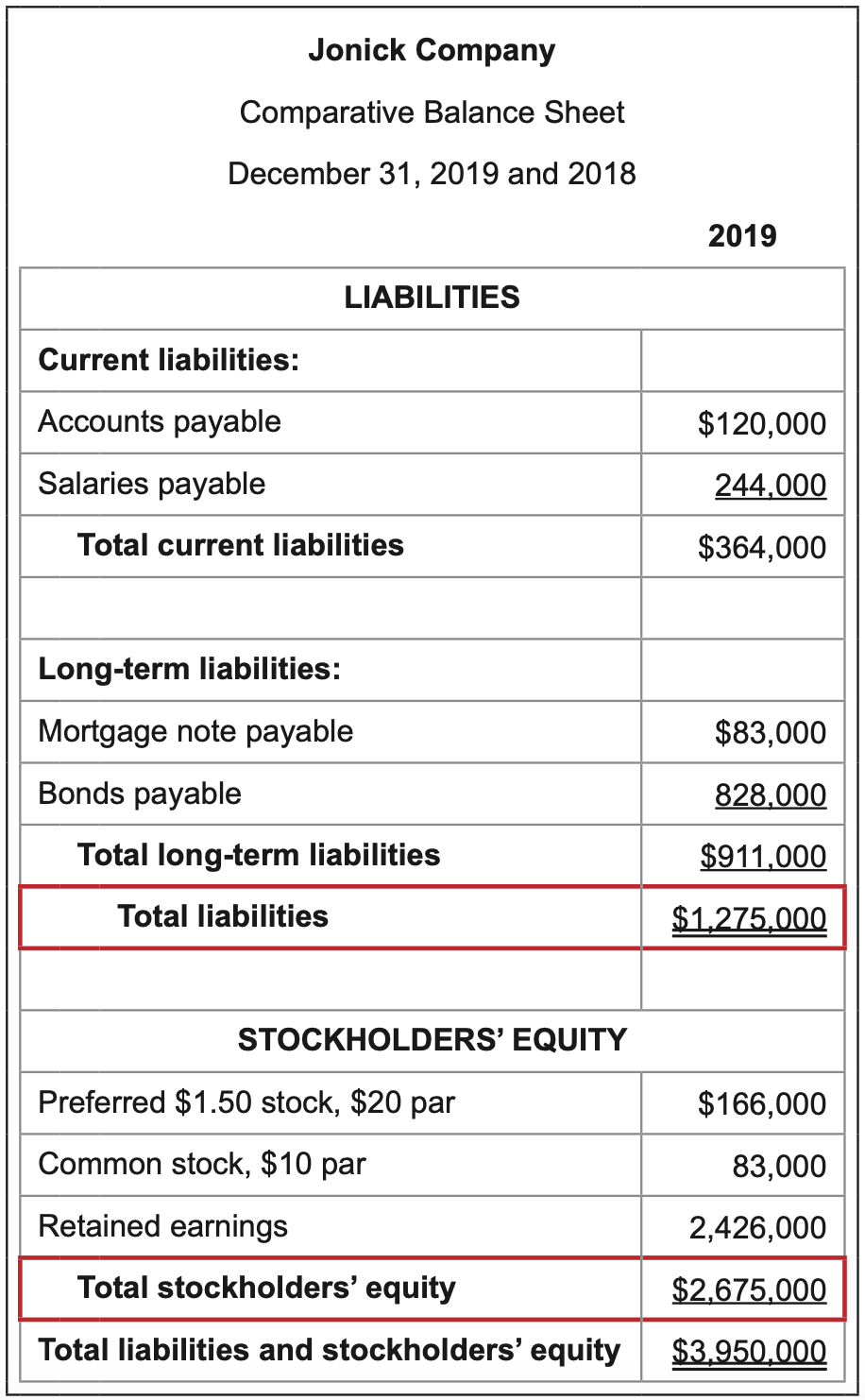
Interpretation: Favorable vs. unfavorable results are based on company’s level of tolerance for debt Assets are acquired either by investments from stockholders or through borrowing from other parties. Companies that are adverse to debt would prefer a lower ratio. Companies that prefer to use “other people’s money” to finance assets would favor a higher ratio. In this example, the company’s debt is about half of what its stockholders’ equity is. Approximately 1/3 of the assets are paid for through borrowing.
RATIO OF FIXED ASSETS TO LONG-TERM LIABILITIES
What it measures: the availability of investments in property, plant, and equipment that are financed by long-term debt and to generate earnings that may be used to pay off long-term debt.
\(\ \text{Calculation}: \frac{\text {Book value of fixed assets }}{\text { Long-term liabilities }}=\frac{1,093,000}{911,000}=1.2\)
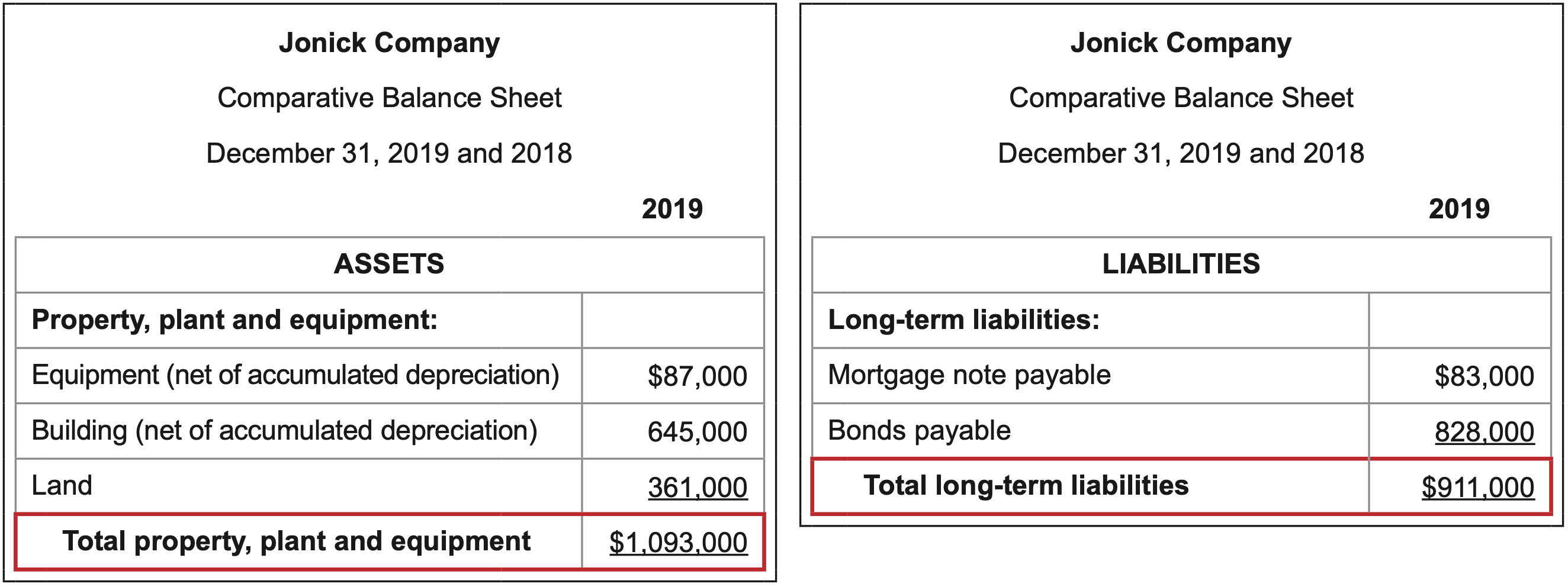
Interpretation: The higher the better. The more that has been invested in fixed assets, which are often financed by long- term debt, the more potential there is for a firm to perform well operationally and generate the cash it needs to make debt payments.
NUMBER OF TIMES INTEREST CHARGES ARE EARNED
What it measures: the ability to generate sufficient pre-tax income to pay interest charges on debt.
\(\ \text{Calculation}: \frac{\text {Income before income tax + interest expense }}{\text { Interest expense }}=\frac{314,000 + 55,000}{55,000}=6.7\)

Since interest expense had been deducted in arriving at income before income tax on the income statement, it is added back in the calculation of the ratio.
Interpretation: The higher the better. The ratio looks at income that is available to pay interest expense after all other expenses have been covered by the sales that were generated. The number of times anything is earned is always more favorable when it is higher since it impacts the margin of safety and the ability to pay as earnings fluctuate, particulary if they decline.

NUMBER OF TIMES PREFERRED DIVIDENDS ARE EARNED
What it measures: the ability to generate sufficient net income to pay dividends to preferred stockholders
\(\ \text{Calculation}: \frac{\text {Net income }}{\text { Preferred dividends }}=\frac{248,000}{12,000}=20.7\)
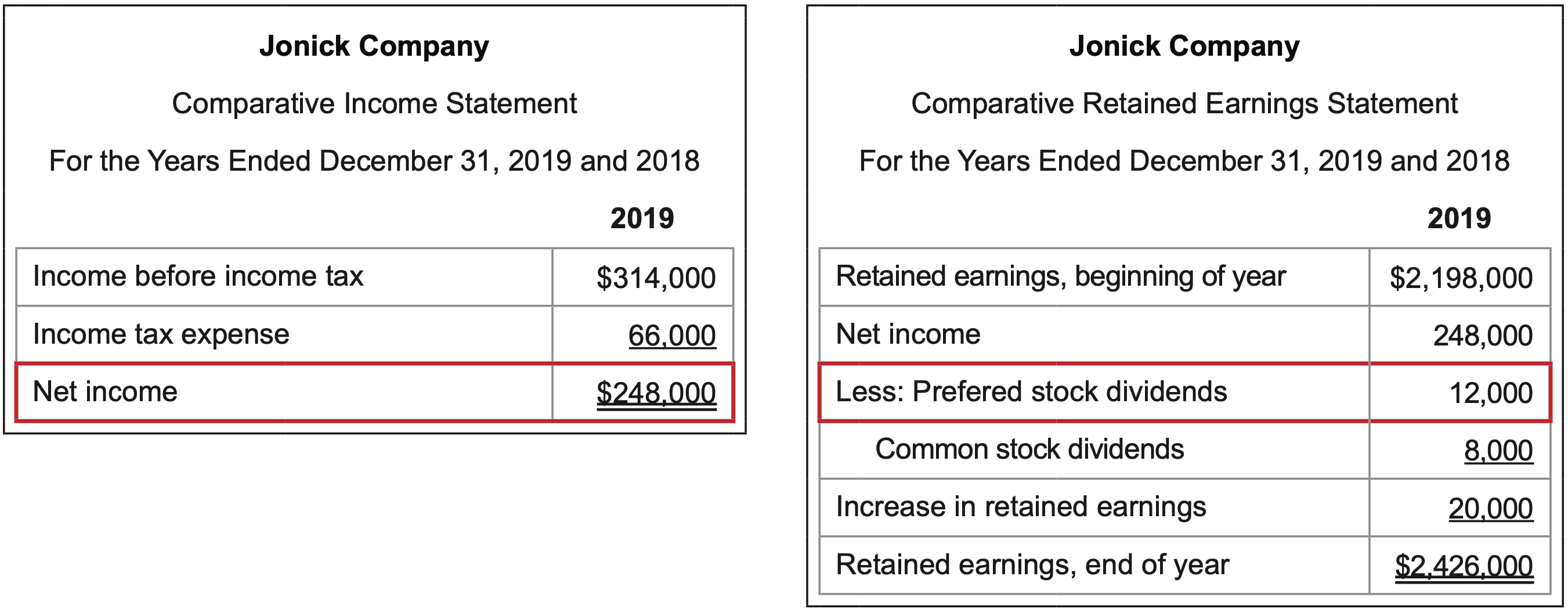
Interpretation: The higher the better. The ratio looks at net income that is available to pay preferred dividends, which are paid on an after-tax basis, and after all expenses have been covered by the sales that were generated. The number of times anything is earned is always more favorable when it is higher since it impacts the margin of safety and the ability to pay as earnings fluctuate.
Profitability analysis evaluates a corporation’s operational ability to generate revenues that exceed associated costs in a given period of time.
Profitability ratios may incorporate the concept of leverage , which is how effectively one financial element generates a progressively larger return on another element. Thes first five ratios that follow look at how well the assets, liabilities, or equities in the denominator of each ratio are able produce a relatively high value in the respective numerator. Ths final two ratios evaluate how well sales translate into gross profit and net income.
ASSET TURNOVER
What it measures: how effectively a company uses its assets to generate revenue.
\(\ \text{Calculation}: \frac{\text {Sales }}{\text { Average total assets (excluding long-term investments) }}=\frac{994,000}{(3,950,000 - 1,946,000 + 3,606,000 - 1,822,000)/2}=52.5 \)%
Long-term investments are not included in the calculation because they are not productivity assets used to generate sales to customers.

Interpretation: The higher the better. The ratio looks at the value of most of a company’s assets and how well they are leveraged to produce sales. The goal of owning the assets is that they should generate revenue that ultimately results in cash flow and profit.
RETURN ON TOTAL ASSETS
What it measures: how effectively a company uses its assets to generate net income.
\(\ \text{Calculation}: \frac{\text {Net income + Interest expense }}{\text {Average total assets }}=\frac{248,000 + 55,000}{(3,950,000 + 3,606,000)/2}=8.0 \)%
Interest expense relates to financed assets, so it is added back to net income since how the assets are paid for should be irrelevant.
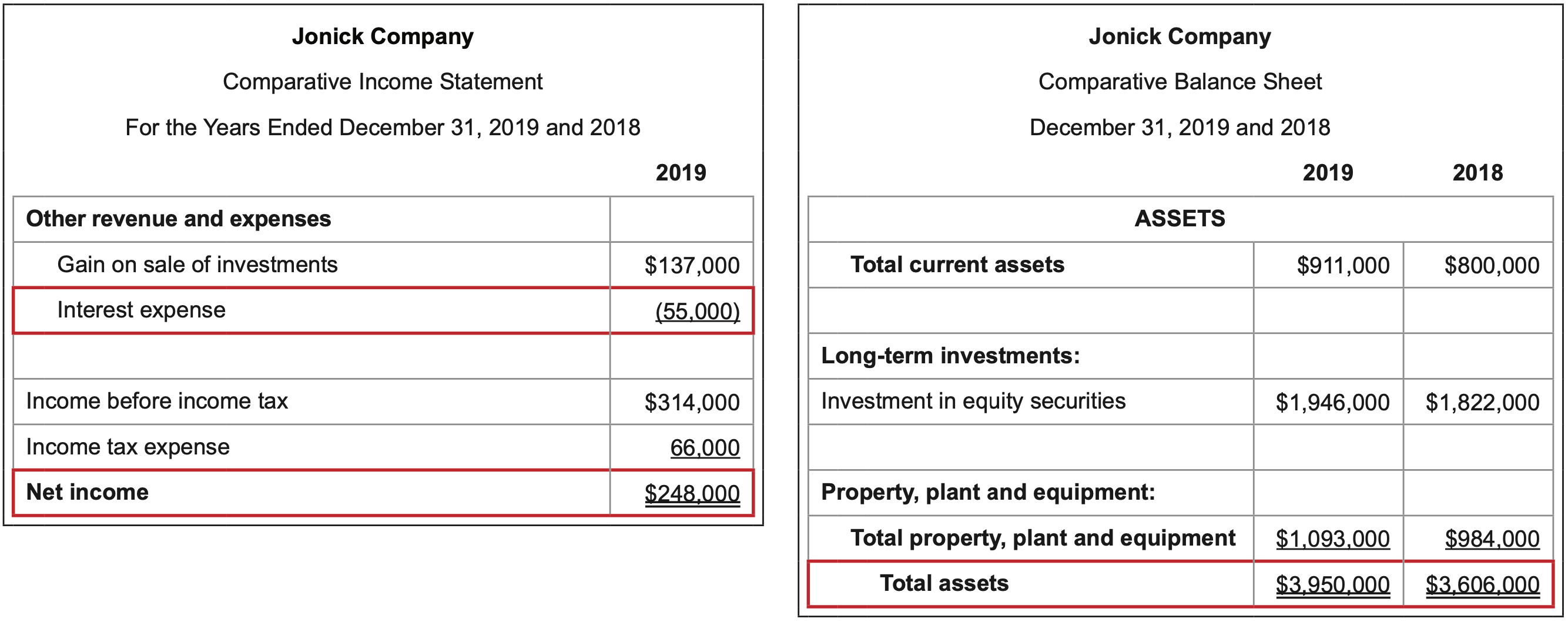
Interpretation: The higher the better. The ratio looks at the value of a company’s assets and how well they are leveraged to produce net income. The goal of owning the assets is that they should generate cash flow and profit.
RETURN ON STOCKHOLDERS’ EQUITY
What it measures: how effectively a company uses the investment of its owners to generate net income.
\(\ \text{Calculation}: \frac{\text {Net income }}{\text { Average total stockholders’ equity }}=\frac{248,000}{(2,675,000 + 2,447,000)/2}= 9.7\)%

Interpretation: The higher the better. The ratio looks at how well the investments of preferred and common stockholders are leveraged to produce net income. One goal of investing in a corporation is for stockholders to accumulate additional wealth as a result of the company making a profit.
RETURN ON COMMON STOCKHOLDERS’ EQUITY (ROE)
What it measures: how effectively a company uses the investment of its common stockholders to generate net income; overall performance of a business.
\(\ \text{Calculation}: \frac{\text {Net income - Preferred dividends }}{\text { Average common stockholders’ equity }}=\frac{248,000 - 12,000}{(83,000 + 2,426,000 + 83,000 + 2,198,000)/2}= 9.9\)%
Preferred dividends are removed from the net income amount since they are distributed prior to commonshareholders having any claim on company profits.
In this example, shareholders saw a 9.9% return on their investment. The result indicates that every dollar of common shareholder’s equity earned about $.10 this year.
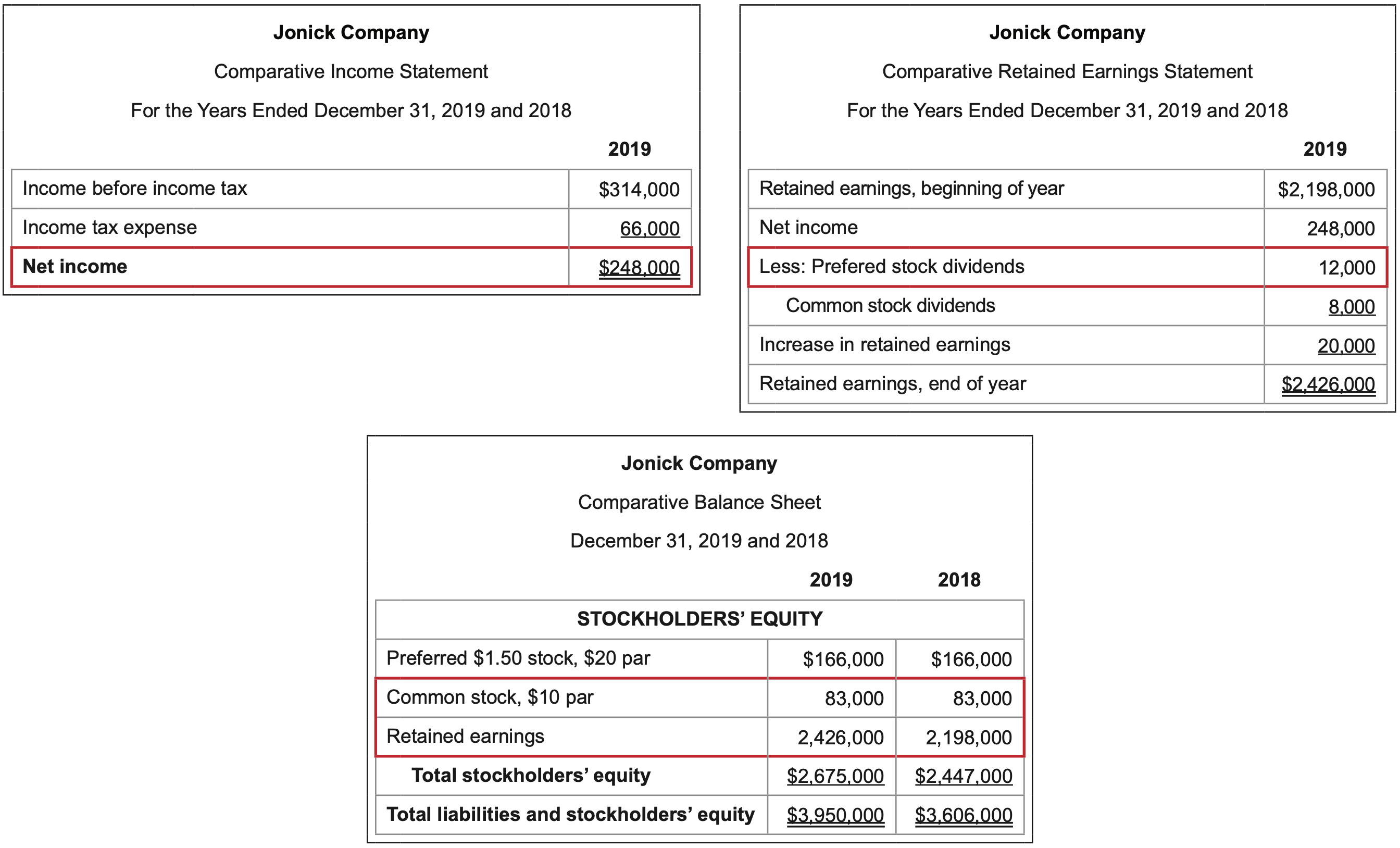
EARNINGS PER SHARE ON COMMON STOCK
What it measures: the dollar amount of net income associated with each share of common stock outstanding.
\(\ \text{Calculation}: \frac{\text {Net income - Preferred dividends }}{\text { Number of shares of common stock outstanding }}=\frac{248,000 - 12,000}{83,000/$10}= $28.43\)
Preferred dividends are removed from the net income amount since they are distributed prior to common shareholders having any claim on company profits.
The number of common shares outstanding is determined by dividing the common stock dollar amount by the par value per share given.
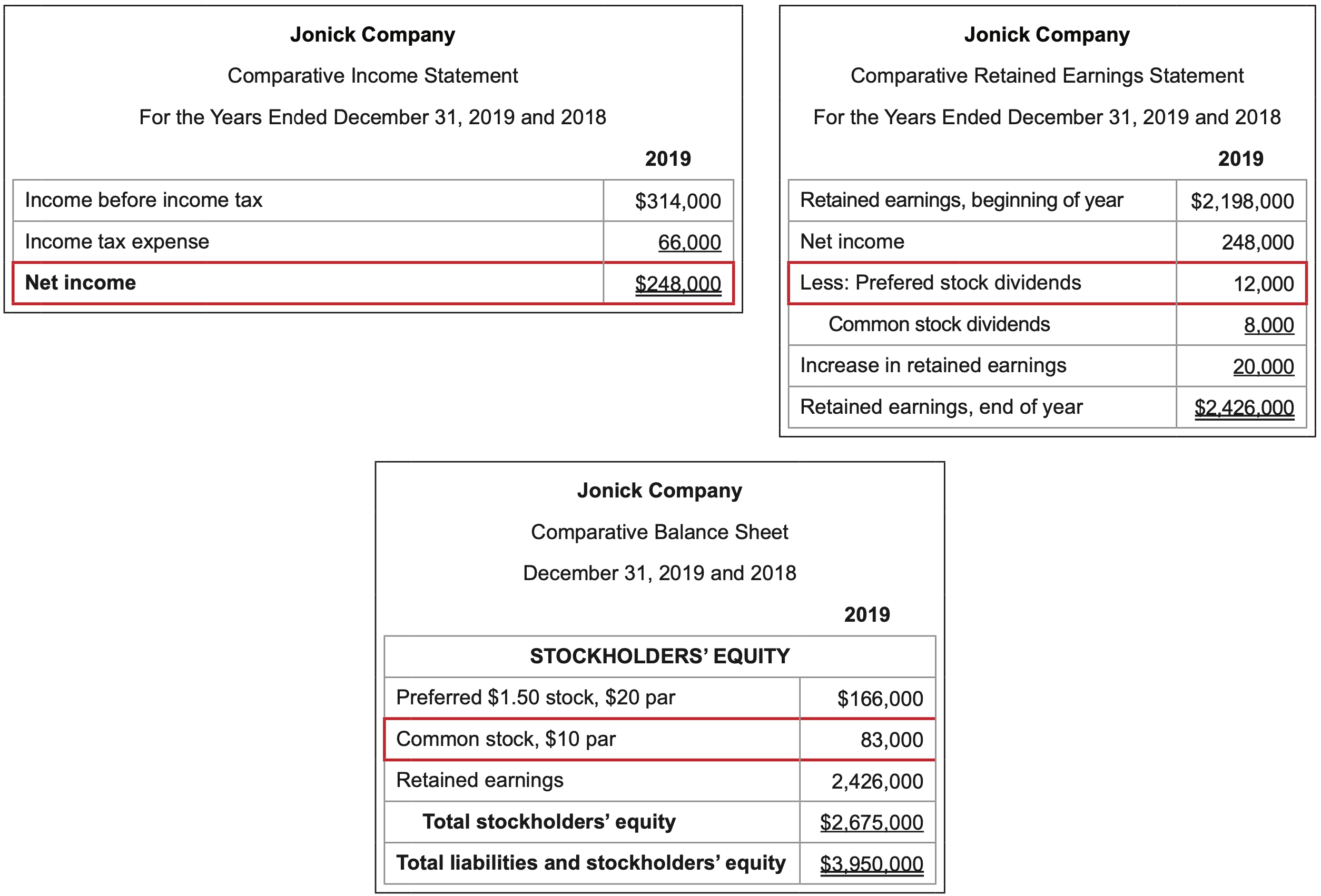
Interpretation: The higher the better. The ratio is critical in reporting net income at a micro level – per share – rather than in total. A greater net income amount will result in a higher earnings per share given a fixed number of shares.
GROSS PROFIT PERCENTAGE
What it measures: how effectively a company generates gross profit from sales or controls cost of merchandise sold.
\(\ \text{Calculation}: \frac{\text {Gross profit }}{\text { Sales }}=\frac{580,000}{994,000}= 58.4\)%
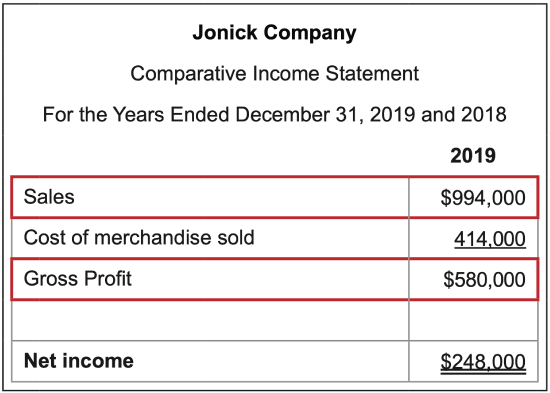
Interpretation: The higher the better. The ratio looks at the main cost of a merchandising business – what it pays for the items it sells. The lower the cost of merchandise sold, the higher the gross profit, which can then be used to pay operating expenses and to generate profit.
PROFIT MARGIN
What it measures: the amount of net income earned with each dollar of sales generated.
\(\ \text{Calculation}: \frac{\text {Net income }}{\text { Sales }}=\frac{248,000}{994,000}= 24.9\)%
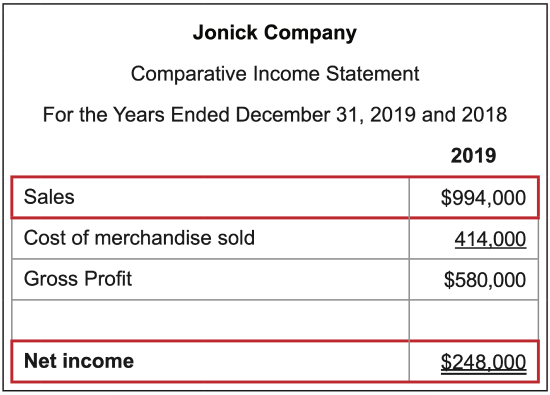
Interpretation: The higher the better. The ratio shows what percentage of sales are left over after all expenses are paid by the business.
Finally, a Dupont analysis breaks down three components of the return on equity ratio to explain how a company can increase its return for investors. It may be evaluated on a relative basis, comparing a company’s Dupont results with either another company’s results, with industry standards, or with expected or desired results.
DUPONT ANALYSIS
What it measures: a company’s ability to increase its return on equity by analyzing what is causing the current ROE.
Results indicate that Company A has a higher profit margin and greater financial leverage. Its weaker position on total asset turnover as compared to Company B is what brings down its ROE. The analysis of the components of ROE provides insight of areas to address for improvement.
Interpretation: Investors are not looking for large or small output numbers from this model. Investors want to analyze and pinpoint what is causing the current ROE to identify areas for improvement. This model breaks down the return on equity ratio to explain how companies can increase their return for investors.
Return-on-investment analysis looks at actual distributions of current earnings or expected future earnings.
DIVIDENDS PER SHARE ON COMMON STOCK
What it measures: the dollar amount of dividends associated with each share of common stock outstanding.
\(\ \text{Calculation}: \frac{\text {Common stock dividends }}{\text { Number of shares of common stock outstanding }}=\frac{8,000}{83,000/$10}= $0.96\)
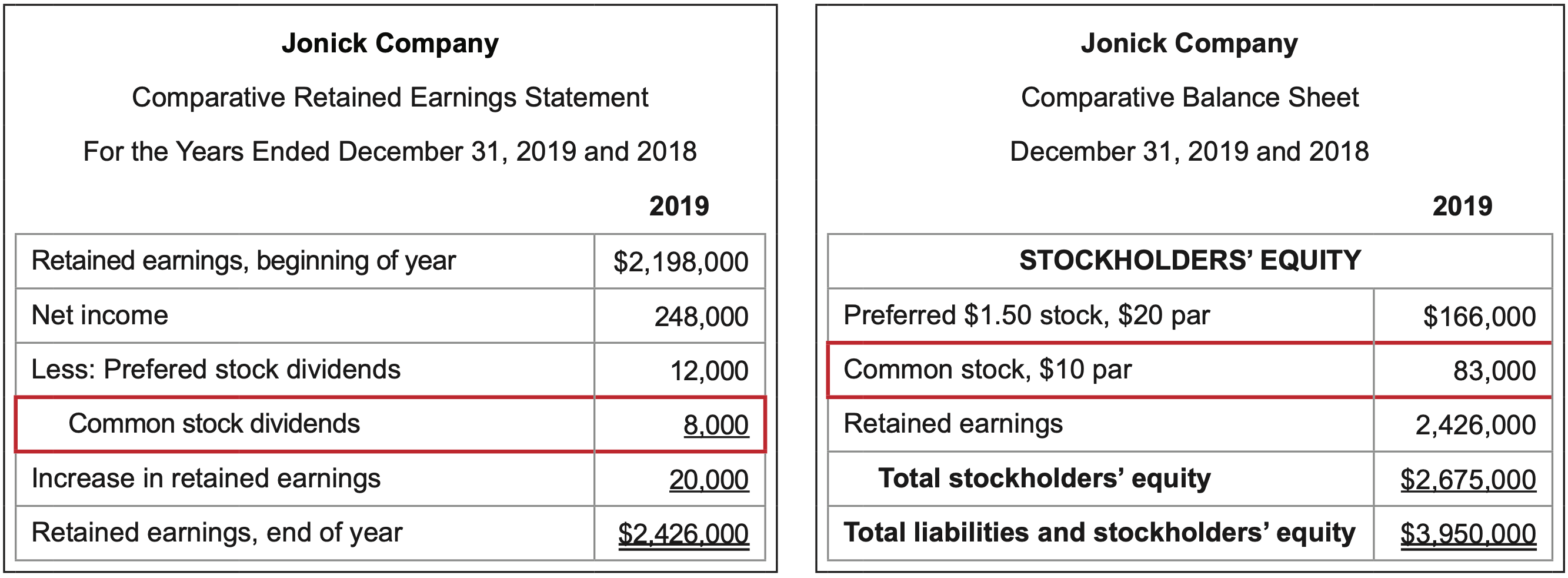
Interpretation: If stockholders desire maximum dividends payouts, then the higher the better. However, some stockholders prefer to receive minimal or no dividends since dividend payouts are taxable or because they prefer that their returns be reinvested. Then lower payouts would be better.
The ratio reports distributions of net income in the form of cash at a micro level – per share – rather than in total. A greater dividends per share amount will result from a higher net income amount given a fixed number of shares.
DIVIDENDS YIELD
What it measures: the rate of return to common stockholders from cash dividends.
Assume that the market price per share is $70.00.
\(\ \text{Calculation}: \frac{\text {Common dividends / Common shares outstanding }}{\text { Market price per share }}=\frac{$0.96}{$70.00}= 1.4\)%

Interpretation: If stockholders desire maximum dividend payouts, then the higher the better. However, some stockholders prefer to receive minimal or no dividends since dividend payouts are taxable or because they prefer that their returns be reinvested. Then lower payouts would be better.
The ratio compares common stock distributions to the current market price. This conversion allows comparison between different companies and may be of particular interest to investors who wish to maximize dividend revenue.
PRICE EARNINGS RATIO
What it measures: the prospects of future earnings.
\(\ \text{Calculation}: \frac{\text {Market price per share }}{\text { Common stock earnings per share }}=\frac{$70.00}{$28.43}= 2.5\)
Recall that earnings per share is (Net income – Preferred stock dividends) / Number of shares of common stock.

Interpretation: The higher the better. The more the market price exceeds earnings, the greater the prospect of value growth, particularly if this ratio increases over time.All the analytical measures discussed, taken individually and collectively, are used to evaluate a company’s operating performance and financial strength. They are particularly informative when compared over time to expected or desired standards. The ability to learn from the financial statements makes the processes of collecting, analyzing, summarizing, and reporting financial information all worthwhile.
Financial Statements: Essential Guide to Analysis and Interpretation
- Banking & Finance
- Bookkeeping
- Business Operations
- Starting a Business

Financial statements are vital tools for understanding the financial health and performance of a business. These documents provide a comprehensive overview of a company’s financial activities, allowing investors, analysts, and other stakeholders to make informed decisions about the business’s value and future prospects. Financial statements are primarily made up of four main components: the balance sheet, income statement, cash flow statement, and statement of changes in equity.
Each of these components plays a crucial role in painting a complete picture of a company’s financial situation. The balance sheet outlines a company’s assets, liabilities, and shareholders’ equity, showcasing its net worth at a specific point in time. The income statement, on the other hand, illustrates a company’s revenues and expenses over a particular period, indicating its profitability. The cash flow statement displays the inflow and outflow of cash within a business, highlighting its liquidity and financial flexibility. Lastly, the statement of changes in equity depicts alterations to a company’s equity over time, reflecting the distribution of profits and additional investments or withdrawals by owners.
Key Takeaways
- Financial statements provide a comprehensive understanding of a company’s financial health.
- The four main components are balance sheet, income statement, cash flow statement, and statement of changes in equity.
- These statements equip stakeholders with crucial information for decision-making and valuation purposes.
Understanding Financial Statements
Financial statements are formal records that represent a company’s financial activities and position. They are essential tools for decision-making, whether for internal management or external parties, such as investors and creditors. In this section, we will discuss the different types of financial statements, their components, and why they are crucial for stakeholders.
Types of Financial Statements
There are four main types of financial statements:
- Income Statement: Determines a company’s profitability by listing revenue and expenses for a specific period.
- Balance Sheet: Presents a company’s financial position by displaying its assets, liabilities, and equity at a particular point in time.
- Cash Flow Statement: Examines a company’s cash inflows and outflows by categorizing them into operating, investing, and financing activities.
- Statement of Comprehensive Income: This statement displays the changes in equity, including both profits and losses, during a specific period.
Components of Financial Statements
Each financial statement has unique components that provide valuable insights into a company’s financial performance and health. Below are some of the primary components:
Income Statement:
- Revenue: The money a company earns from selling goods or providing services.
- Cost of Goods Sold (COGS): The direct costs associated with producing goods or delivering services.
- Operating Expenses: The indirect costs incurred to run the business, such as salaries, rent, and utilities.
- Net Income: The final profit or loss after considering all revenue and expenses.
Balance Sheet:
- Assets: Resources owned by a company that have economic value.
- Liabilities: The financial obligations a company owes to other parties.
- Equity: The residual interest in the assets after deducting liabilities. It represents the owners’ claims on the company’s assets.
Cash Flow Statement:
- Operating Activities: Cash flows related to a company’s core business operations.
- Investing Activities: Cash flows from transactions involving long-term assets, such as purchasing or selling property, plant, and equipment.
- Financing Activities: Cash flows related to raising or repaying capital, such as issuing stocks or paying dividends.
Importance of Financial Statements
Financial statements play a critical role in helping various stakeholders understand a company’s financial position and performance. Some notable benefits include:
- Decision-making: Management uses financial statements to make informed decisions about the company’s operations, resource allocation, and future plans.
- Performance Evaluation: Financial statements allow stakeholders to gauge a company’s profitability, liquidity, solvency, and overall financial health.
- Investor and Creditor Analysis: Investors and creditors review financial statements to assess the risk and potential return before making financing or investment decisions.
- Regulatory Compliance: Companies must adhere to accounting standards and regulations when preparing financial statements, ensuring transparency and comparability between different businesses.
The Balance Sheet
The balance sheet is a crucial financial statement that provides a snapshot of a company’s financial position at a specific point in time. It consists of three main components: assets , liabilities , and shareholders’ equity . The balance sheet follows the fundamental accounting equation:
Total Assets = Liabilities + Shareholders’ Equity
Assets are the resources a company owns or controls with the expectation that they will provide future economic benefit. They are classified into two main categories:
- Current assets : These are short-term assets, expected to be converted to cash or used within one year. Examples include cash, accounts receivable, inventory, and prepaid expenses.
- Non-current assets : Also known as long-term or fixed assets, these are not expected to be converted to cash within one year. Examples include property, plant and equipment (PPE), intangible assets (such as patents and trademarks), and long-term investments.
Liabilities
Liabilities represent the company’s obligations to other parties, such as payments to suppliers or borrowed funds. Similar to assets, they are also divided into two categories:
- Current liabilities : These are short-term obligations, expected to be settled within a year. Examples include accounts payable, short-term debt, and accrued expenses.
- Non-current liabilities : Also known as long-term liabilities, these obligations are not expected to be settled within one year. Examples include long-term debt, deferred tax liabilities, and pension obligations.
Shareholders’ Equity
Shareholders’ equity, also known as net worth or owner’s equity, represents the residual interest in the assets of a company after deducting liabilities. In other words, it is the value left for the company’s owners if all assets were used to pay off all liabilities. The main components of shareholders’ equity are:
- Common stock: This represents the initial investment made by shareholders, also known as paid-in capital.
- Retained earnings: These are the accumulated earnings (or losses) of a company that have been reinvested, rather than distributed as dividends.
- Treasury stock: This refers to the company’s own shares that have been repurchased but not yet retired or cancelled.
- Other comprehensive income: This includes the gains and losses that are not included in the net income calculation, such as unrealized gains or losses on investments.
Together, the balance sheet provides a comprehensive view of a company’s financial position, illustrating the relationship between its assets, liabilities, and shareholders’ equity at a specific moment in time.
The Income Statement
The income statement is a crucial financial statement that reflects a company’s financial performance over a specific accounting period. It displays a company’s revenue, expenses, and the resulting profit or loss. The income statement is essential for understanding the financial health of a business and is often referred to as a profit and loss (P&L) statement or statement of earnings.
Revenue, also known as sales or income , represents the total amount of money a company earns from its operations. It is typically presented as the top line of the income statement. Revenue can be generated from various sources, such as product sales, rendering services, or interest and dividend income from investments.
Expenses are the costs incurred by a business to generate revenue. There are several types of expenses on an income statement, some of which include:
- Cost of Goods Sold (COGS) : The direct cost of producing the goods or services that a company sells. This may include the raw materials, labor, and manufacturing expenses.
- Operating Expenses : The indirect costs associated with running a business, such as sales and marketing, office expenses, and rent.
- Depreciation and Amortization : The systematic allocation of the cost of tangible and intangible assets over their estimated useful life.
- Interest Expense : The cost of borrowing money to finance the company’s operations.
- Taxes : The financial obligation a company owes to federal, state, and local governments.
Profit or Loss
The income statement highlights several key indicators of a company’s financial performance, such as:
- Gross Profit : Calculated as Revenue – Cost of Goods Sold . This indicates how much money the company makes from selling its products or services before accounting for operating expenses.
- Operating Profit (EBIT) : Calculated as Gross Profit – Operating Expenses . It represents the profit a company generates from its core business operations, without considering non-operating activities and financing costs.
- Net Income (Profit or Loss) : This is the bottom line of the income statement, which shows the overall profit or loss of a company after considering all revenue and expenses for a specific period. It is calculated as Operating Profit – Non-operating Expenses + Non-operating Income – Taxes .
- Gross Margin : Expressed as a percentage, this shows the proportion of gross profit to revenue. It represents a company’s efficiency in converting raw materials and labor into income.
An income statement serves as a vital tool for investors, managers, and other stakeholders to assess a company’s financial performance and make informed decisions.
The Cash Flow Statement
The cash flow statement is a crucial financial statement that summarizes the movement of cash and cash equivalents in and out of a company. It provides essential insights into a company’s liquidity, solvency, and overall financial health.
Operating Activities
Operating activities refer to the primary cash sources and uses generated by a company’s regular business operations. These activities are central to understanding the cash flow statement as they reveal how well a company is generating cash from its core business. Examples of operating cash flows include:
- Cash received from customers
- Cash payments to suppliers and employees
- Interest payments or receipts
- Income tax payments
Typically, cash flow from operating activities is calculated using the indirect method , which starts with net income and adjusts for non-cash items and changes in working capital.
Investing Activities
Investing activities encompass the cash flows from the acquisition and disposal of long-term assets, as well as investment in other companies or securities. These activities provide insights into a company’s strategy for growth and development. Cash flows from investing activities may include:
- Purchase or sale of property, plant, and equipment (PPE)
- Acquisitions or disposals of subsidiaries and other businesses
- Investments in or proceeds from the sale of financial instruments, such as stocks and bonds
A negative cash flow from investing activities indicates that the company is investing in its growth and development, while a positive cash flow signifies that the company is divesting assets.
Financing Activities
Financing activities represent the cash flows related to obtaining and repaying capital through borrowing or equity financing. This section is particularly relevant for assessing a company’s financial structure and its ability to raise or return funds to investors. Common financing cash flows include:
- Issuance or repurchase of a company’s own shares
- Dividend payments to shareholders
- Borrowings or repayments of debt, such as bank loans or bonds
By analyzing the cash flow statement and its three main components, stakeholders can understand a company’s performance in managing its cash resources and evaluate its financial position more accurately.
Analyzing Financial Performance
When analyzing a company’s financial performance, it’s crucial to evaluate its financial statements to understand its overall standing in categories such as assets, liabilities, equity, expenses, revenue, and profitability. In this section, we will explore various methods of analysis, focusing on financial ratios, trends, and comparisons.
Financial Ratios
Financial ratios allow businesses and investors to assess a company’s performance by comparing various financial aspects. Some of the key financial ratios that can be used to analyze a company’s performance include:
- Gross Profit Margin : Calculates the percentage of revenue that remains after deducting the cost of goods sold (COGS). Gross Profit Margin = (Revenue – COGS) / Revenue
- Return on Equity (ROE) : Measures the company’s ability to generate profits from its shareholders’ equity. ROE = Net Income / Shareholders’ Equity
- Current Ratio : Indicates a company’s ability to pay its short-term liabilities using its short-term assets. Current Ratio = Current Assets / Current Liabilities
- Quick Ratio : Also known as the acid-test ratio, it’s a more stringent measure of liquidity. Quick Ratio = (Current Assets – Inventory) / Current Liabilities
- Asset Turnover : Shows how efficiently a company generates revenue from its assets. Asset Turnover = Revenue / Average Total Assets
- Inventory Turnover : Measures how quickly a company sells its inventory. Inventory Turnover = COGS / Average Inventory
Trends and Comparisons
Analyzing trends and making comparisons with industry benchmarks can also provide valuable insights into a company’s financial performance. Some of the commonly used methods are:
- Horizontal analysis : This method involves comparing financial statement items over time to identify trends and changes in the company’s performance. For instance, one could compare a company’s revenue growth over multiple periods.
- Vertical analysis : Also known as common-size analysis, this method expresses each item in the financial statement as a percentage of a base number. For example, in the income statement, each item can be expressed as a percentage of revenue, allowing for better comparisons across companies of different sizes.
- Industry comparisons : Comparing a company’s financial ratios and performance metrics to industry averages or competitors’ data can highlight its strengths and weaknesses. This helps in understanding a company’s position within its industry and guides decision-making.
Taking the time to analyze financial performance using financial ratios, trends, and comparisons is crucial in making well-informed decisions regarding a company’s health and potential for growth.
The Role of Standards and Regulations
Financial statements play a critical role in providing essential information to investors, creditors, and other stakeholders. To ensure transparency, reliability, and comparability of these statements, there are standard-setting organizations and regulatory bodies that provide guidelines and enforce compliance.
GAAP and IFRS
Generally Accepted Accounting Principles (GAAP) and International Financial Reporting Standards (IFRS) are two prominent sets of accounting standards, aimed at enhancing consistency and comparability of financial statements.
- GAAP : Predominantly used in the United States, GAAP is a collection of guidelines and rules issued by the Financial Accounting Standards Board (FASB). It covers multiple aspects of financial reporting, from revenue recognition to asset valuation.
- IFRS : Developed by the International Accounting Standards Board (IASB), IFRS is a set of principles that provide a global framework for preparing and presenting financial statements. It is applicable in more than 100 countries and focuses on principles-based accounting, allowing for greater flexibility in applying accounting policies.
One key distinction between GAAP and IFRS is their methodology:
Both systems aim to enhance financial statement analysis by promoting transparency and consistency.
SEC Regulations and Compliance
For public companies, regulatory bodies such as the Securities and Exchange Commission (SEC) in the United States oversee compliance with accounting standards and financial reporting requirements. The SEC mandates that publicly-traded companies adhere to GAAP when preparing their financial statements.
SEC regulations dictate various reporting aspects, including:
- Filing of periodic financial reports
- Ensuring timely disclosure of material information
- Upholding accuracy and integrity in financial reporting
- Imposing penalties for non-compliance
In essence, the role of standards and regulations is to safeguard the interests of financial statement users by establishing a robust framework for financial accounting and reporting. GAAP, IFRS, and SEC regulations collectively contribute to transparent, reliable, and comparable financial information, promoting better decision-making among investors and other stakeholders.
Advanced Financial Statement Concepts
Earnings and dividends.
Earnings per share (EPS) is a crucial financial metric in determining a company’s profitability. It represents the portion of a company’s profit allocated to each outstanding share of common stock. To calculate EPS, divide the net income by the weighted average number of outstanding shares.
Comprehensive income encompasses all components of income and changes in equity other than transactions with stockholders, such as net income and other comprehensive income. It gives a holistic view of an organization’s financial performance.
Dividends are payments made by a corporation to its shareholders, usually from its net profits. Dividends can be in the form of cash, stock, or other assets. Retained earnings are the portion of net income that is retained by the company rather than being distributed as dividends. They are used for reinvestment in the company or to pay off debt.
Financial statements, such as income statements and cash flow statements , help analyze a company’s earnings and dividends. The income statement presents the company’s revenues, expenses, and profits, while the cash flow statement provides information about cash inflows and outflows.
Amortization and Depreciation
Both amortization and depreciation are accounting methods used to allocate the cost of an asset over its useful life. However, they apply to different types of assets.
Amortization applies to intangible assets, such as patents, trademarks, or licenses. It is the systematic allocation of an intangible asset’s cost over its useful life.
Depreciation applies to tangible assets, such as buildings, machinery, and equipment. It is the systematic allocation of a tangible asset’s cost over its useful life. Depreciation helps account for the wear and tear of assets over time.
The following table shows the key differences between amortization and depreciation:
Both amortization and depreciation are important concepts in financial statements, specifically in the income statement and the cash flow statement. They also influence the statement of changes in equity , which presents the equity changes resulting from transactions with owners and other comprehensive income.
Financial Statements in Decision Making
Investors and stakeholders.
Financial statements play a crucial role in decision-making for investors and stakeholders. These documents provide insight into a company’s financial health, allowing interested parties to assess the business’s value, creditworthiness, and potential risks. The main financial statements that are essential in decision-making are the balance sheet, income statement, and the cash flow statement.
- The balance sheet offers a snapshot of the company’s assets, liabilities, and equity at a specific point in time.
- The income statement displays the company’s net earnings or losses within a specified period. It is a valuable tool for calculating the profit margin and analyzing overall revenue and expenses.
- The cash flow statement outlines the cash inflows and outflows, enabling stakeholders to understand how the company manages its cash and assess its liquidity position.
These financial statements are particularly significant for external stakeholders, such as investors, who rely on this information to make informed decisions about the company’s potential for growth and profitability. The analysis of annual financial statements can indicate trends, helping stakeholders project future performance and calculate the present value of potential investments.
Risk and Return Analysis
A proper analysis of financial statements enables stakeholders to evaluate the associated risks and returns of the business. By examining various financial ratios and metrics, investors can determine the stability of the company and its ability to generate returns on their investments. Some essential metrics usually considered are:
- Debt-to-Equity Ratio : Indicates the proportion of debt in the company’s capital structure; a higher ratio can signify higher risks.
- Current Ratio : Measures liquidity by comparing a company’s current assets to its current liabilities. A ratio greater than 1 suggests that the company can meet its short-term obligations.
- Return on Equity : Represents the financial performance of the company, revealing how effectively the company generates profit from its shareholders’ investments.
Through a comprehensive analysis of financial statements, investors and stakeholders can identify the potential risks and make informed decisions regarding their involvement with the company. Ultimately, these documents serve as crucial tools for assessing the performance, stability, and growth potential of a business, aiding in effective decision-making for those seeking to invest or deepen their involvement with an organization.
Frequently Asked Questions
What are the major components included in a complete set of financial statements.
A complete set of financial statements includes an income statement, a balance sheet, a statement of cash flows, and a statement of retained earnings or equity. Additionally, accompanying footnotes provide essential contextual information and explain the basis of presentation and accounting policies.
How do the different types of financial statements serve various stakeholders?
Different stakeholders, such as investors, creditors, management, and regulatory authorities, rely on financial statements to assess the financial health of a company. These statements provide insights into a company’s profitability, liquidity, solvency, and overall financial position, enabling stakeholders to make informed decisions about investing in or lending to the company.
Can you describe the key differences between income statements, balance sheets, and cash flow statements?
An income statement summarizes a company’s revenues, expenses, and net income (or loss) for a specific period. It demonstrates the company’s profitability and operational efficiency.
A balance sheet presents a company’s assets, liabilities, and shareholders’ equity at a specific point in time. It provides a snapshot of a company’s financial position and reveals its liquidity and solvency.
A cash flow statement outlines the cash inflows and outflows resulting from operating, investing, and financing activities during a particular period. This statement helps stakeholders assess a company’s ability to generate cash and meet its financial obligations.
What role do financial statements play in business decision-making and investor evaluations?
Financial statements serve as a fundamental tool in business decision-making and investor evaluations. They help management identify trends, assess profitability, and make informed strategic decisions, such as investments or cost-cutting measures. Investors use these statements to analyze a company’s financial performance, compare it with competitors, and determine its attractiveness as an investment opportunity.
Why is financial statement analysis important for investors and creditors?
Financial statement analysis is critical for investors and creditors because it helps them assess a company’s financial health, future prospects, and potential risks. By using techniques such as ratio analysis, trend analysis, and common size analysis, they can evaluate a company’s liquidity, solvency, profitability, and efficiency, which are essential factors in making investment and lending decisions.
How do financial statements reflect a company’s financial health and performance over a given period?
Financial statements provide a comprehensive assessment of a company’s financial health and performance by quantifying its financial activities during a specified period. They highlight trends in revenue growth, profitability, asset utilization, and cash generation, enabling stakeholders to gain a clear understanding of the company’s financial standing and its ability to meet short- and long-term obligations. The periodic nature of these statements allows stakeholders to monitor a company’s progress over time and make well-informed decisions accordingly.
- 1-800-711-3307
- Expense management
- Corporate card
- Tax returns & preparation
- Payment processing
- Tax compliance
- Vision & clarity
- Accounting mobile app
- Reduce your accounting expenses
- What does a bookkeeper do
- Why outsource
- Cash vs. Accrual Accounting
- Guides & ebooks
- How Finally works
- Privacy policy
- Terms of service
*Finally is not a CPA firm © 2024 Finally, Backoffice.co , Inc. All rights reserved.

- Business Essentials
- Leadership & Management
- Credential of Leadership, Impact, and Management in Business (CLIMB)
- Entrepreneurship & Innovation
- *New* Digital Transformation
- Finance & Accounting
- Business in Society
- For Organizations
- Support Portal
- Media Coverage
- Founding Donors
- Leadership Team

- Harvard Business School →
- HBS Online →
- Business Insights →
Business Insights
Harvard Business School Online's Business Insights Blog provides the career insights you need to achieve your goals and gain confidence in your business skills.
- Career Development
- Communication
- Decision-Making
- Earning Your MBA
- Negotiation
- News & Events
- Productivity
- Staff Spotlight
- Student Profiles
- Work-Life Balance
- Alternative Investments
- Business Analytics
- Business Strategy
- Business and Climate Change
- Design Thinking and Innovation
- Digital Marketing Strategy
- Disruptive Strategy
- Economics for Managers
- Entrepreneurship Essentials
- Financial Accounting
- Global Business
- Launching Tech Ventures
- Leadership Principles
- Leadership, Ethics, and Corporate Accountability
- Leading with Finance
- Management Essentials
- Negotiation Mastery
- Organizational Leadership
- Power and Influence for Positive Impact
- Strategy Execution
- Sustainable Business Strategy
- Sustainable Investing
- Winning with Digital Platforms
The Beginner’s Guide to Reading & Understanding Financial Statements

- 10 Jun 2020
An ability to understand the financial health of a company is one of the most vital skills for aspiring investors, entrepreneurs, and managers to develop. Armed with this knowledge, investors can better identify promising opportunities while avoiding undue risk, and professionals of all levels can make more strategic business decisions.
Financial statements offer a window into the health of a company, which can be difficult to gauge using other means. While accountants and finance specialists are trained to read and understand these documents, many business professionals are not. The effect is an obfuscation of critical information.
If you’re new to the world of financial statements, this guide can help you read and understand the information contained in them.
Access your free e-book today.
Understanding Financial Statements
To understand a company’s financial position—both on its own and within its industry—you need to review and analyze several financial statements: balance sheets, income statements, cash flow statements, and annual reports. The value of these documents lies in the story they tell when reviewed together.
1. How to Read a Balance Sheet
A balance sheet conveys the “book value” of a company. It allows you to see what resources it has available and how they were financed as of a specific date. It shows its assets, liabilities, and owners’ equity (essentially, what it owes, owns, and the amount invested by shareholders).
The balance sheet also provides information that can be leveraged to compute rates of return and evaluate capital structure, using the accounting equation: Assets = Liabilities + Owners’ Equity.

Assets are anything a company owns with quantifiable value.
Liabilities refer to money a company owes to a debtor, such as outstanding payroll expenses, debt payments, rent and utility, bonds payable, and taxes.
Owners’ equity refers to the net worth of a company. It’s the amount of money that would be left if all assets were sold and all liabilities paid. This money belongs to the shareholders, who may be private owners or public investors.
Alone, the balance sheet doesn’t provide information on trends, which is why you need to examine other financial statements, including income and cash flow statements, to fully comprehend a company’s financial position.
This article will teach you more about how to read a balance sheet .
2. How to Read an Income Statement
An income statement , also known as a profit and loss (P&L) statement, summarizes the cumulative impact of revenue, gain, expense, and loss transactions for a given period. The document is often shared as part of quarterly and annual reports, and shows financial trends, business activities (revenue and expenses), and comparisons over set periods.
Income statements typically include the following information:
- Revenue: The amount of money a business takes in
- Expenses: The amount of money a business spends
- Costs of goods sold (COGS): The cost of component parts of what it takes to make whatever a business sells
- Gross profit: Total revenue less COGS
- Operating income: Gross profit less operating expenses
- Income before taxes: Operating income less non-operating expenses
- Net income: Income before taxes less taxes
- Earnings per share (EPS): Division of net income by the total number of outstanding shares
- Depreciation: The extent to which assets (for example, aging equipment) have lost value over time
- EBITDA: Earnings before interest, taxes, depreciation, and amortization
Accountants, investors, and other business professionals regularly review income statements:
- To understand how well their company is doing: Is it profitable? How much money is spent to produce a product? Is there cash to invest back into the business?
- To determine financial trends: When are costs highest? When are they lowest?
This article will teach you more about how to read an income statement .
Related: Financial Terminology: 20 Financial Terms to Know
3. How to Read a Cash Flow Statement
The purpose of a cash flow statement is to provide a detailed picture of what happened to a business’s cash during a specified duration of time, known as the accounting period. It demonstrates an organization’s ability to operate in the short and long term, based on how much cash is flowing into and out of it.
Cash flow statements are broken into three sections: Cash flow from operating activities, cash flow from investing activities, and cash flow from financing activities.
Operating activities detail cash flow that’s generated once the company delivers its regular goods or services, and includes both revenue and expenses. Investing activity is cash flow from purchasing or selling assets—usually in the form of physical property, such as real estate or vehicles, and non-physical property, like patents—using free cash, not debt. Financing activities detail cash flow from both debt and equity financing.
It’s important to note there’s a difference between cash flow and profit . While cash flow refers to the cash that's flowing into and out of a company, profit refers to what remains after all of a company’s expenses have been deducted from its revenues. Both are important numbers to know.
With a cash flow statement, you can see the types of activities that generate cash and use that information to make financial decisions .
Ideally, cash from operating income should routinely exceed net income, because a positive cash flow speaks to a company’s financial stability and ability to grow its operations. However, having positive cash flow doesn’t necessarily mean a company is profitable, which is why you also need to analyze balance sheets and income statements.
This article will teach you more about how to read a cash flow statement .
4. How to Read an Annual Report
An annual report is a publication that public corporations are required to publish annually to shareholders to describe their operational and financial conditions.
Annual reports often incorporate editorial and storytelling in the form of images, infographics, and a letter from the CEO to describe corporate activities, benchmarks, and achievements. They provide investors, shareholders, and employees with greater insight into a company’s mission and goals, compared to individual financial statements.
Beyond the editorial, an annual report summarizes financial data and includes a company's income statement, balance sheet, and cash flow statement. It also provides industry insights, management’s discussion and analysis (MD&A), accounting policies, and additional investor information.
In addition to an annual report, the US Securities and Exchange Commission (SEC) requires public companies to produce a longer, more detailed 10-K report, which informs investors of a business’s financial status before they buy or sell shares.
10-K reports are organized per SEC guidelines and include full descriptions of a company’s fiscal activity, corporate agreements, risks, opportunities, current operations, executive compensation, and market activity. You can also find detailed discussions of operations for the year, and a full analysis of the industry and marketplace.
Both an annual and 10-K report can help you understand the financial health, status, and goals of a company. While the annual report offers something of a narrative element, including management’s vision for the company, the 10-K report reinforces and expands upon that narrative with more detail.
This article will teach you more about how to read an annual report .

A Critical Skill
Reviewing and understanding these financial documents can provide you with valuable insights about a company, including:
- Its debts and ability to repay them
- Profits and/or losses for a given quarter or year
- Whether profit has increased or decreased compared to similar past accounting periods
- The level of investment required to maintain or grow the business
- Operational expenses, especially compared to the revenue generated from those expenses
Accountants, investors, shareholders, and company leadership need to be keenly aware of the financial health of an organization, but employees can also benefit from understanding balance sheets, income statements, cash flow statements, and annual reports.
If you don’t have a financial background, the good news is that there are steps you can take to learn about finance and jumpstart your career . Building your financial literacy and skills doesn’t need to be difficult.
Are you interested in gaining a toolkit for making smarter financial decisions and communicating decisions to key stakeholders? Explore our online finance and accounting courses , and download our free course flowchart to determine which best aligns with your goals.

About the Author

- Global (EN)
- Albania (en)
- Algeria (fr)
- Argentina (es)
- Armenia (en)
- Australia (en)
- Austria (de)
- Austria (en)
- Azerbaijan (en)
- Bahamas (en)
- Bahrain (en)
- Bangladesh (en)
- Barbados (en)
- Belgium (en)
- Belgium (nl)
- Bermuda (en)
- Bosnia and Herzegovina (en)
- Brasil (pt)
- Brazil (en)
- British Virgin Islands (en)
- Bulgaria (en)
- Cambodia (en)
- Cameroon (fr)
- Canada (en)
- Canada (fr)
- Cayman Islands (en)
- Channel Islands (en)
- Colombia (es)
- Costa Rica (es)
- Croatia (en)
- Cyprus (en)
- Czech Republic (cs)
- Czech Republic (en)
- DR Congo (fr)
- Denmark (da)
- Denmark (en)
- Ecuador (es)
- Estonia (en)
- Estonia (et)
- Finland (fi)
- France (fr)
- Georgia (en)
- Germany (de)
- Germany (en)
- Gibraltar (en)
- Greece (el)
- Greece (en)
- Hong Kong SAR (en)
- Hungary (en)
- Hungary (hu)
- Iceland (is)
- Indonesia (en)
- Ireland (en)
- Isle of Man (en)
- Israel (en)
- Ivory Coast (fr)
- Jamaica (en)
- Jordan (en)
- Kazakhstan (en)
- Kazakhstan (kk)
- Kazakhstan (ru)
- Kuwait (en)
- Latvia (en)
- Latvia (lv)
- Lebanon (en)
- Lithuania (en)
- Lithuania (lt)
- Luxembourg (en)
- Macau SAR (en)
- Malaysia (en)
- Mauritius (en)
- Mexico (es)
- Moldova (en)
- Monaco (en)
- Monaco (fr)
- Mongolia (en)
- Montenegro (en)
- Mozambique (en)
- Myanmar (en)
- Namibia (en)
- Netherlands (en)
- Netherlands (nl)
- New Zealand (en)
- Nigeria (en)
- North Macedonia (en)
- Norway (nb)
- Pakistan (en)
- Panama (es)
- Philippines (en)
- Poland (en)
- Poland (pl)
- Portugal (en)
- Portugal (pt)
- Romania (en)
- Romania (ro)
- Saudi Arabia (en)
- Serbia (en)
- Singapore (en)
- Slovakia (en)
- Slovakia (sk)
- Slovenia (en)
- South Africa (en)
- Sri Lanka (en)
- Sweden (sv)
- Switzerland (de)
- Switzerland (en)
- Switzerland (fr)
- Taiwan (en)
- Taiwan (zh)
- Thailand (en)
- Trinidad and Tobago (en)
- Tunisia (en)
- Tunisia (fr)
- Turkey (en)
- Turkey (tr)
- Ukraine (en)
- Ukraine (ru)
- Ukraine (uk)
- United Arab Emirates (en)
- United Kingdom (en)
- United States (en)
- Uruguay (es)
- Uzbekistan (en)
- Uzbekistan (ru)
- Venezuela (es)
- Vietnam (en)
- Vietnam (vi)
- Zambia (en)
- Zimbabwe (en)
- Financial Reporting View
- Women's Leadership
- Corporate Finance
- Board Leadership
- Executive Education
Fresh thinking and actionable insights that address critical issues your organization faces.
- Insights by Industry
- Insights by Topic
KPMG's multi-disciplinary approach and deep, practical industry knowledge help clients meet challenges and respond to opportunities.
- Advisory Services
- Audit Services
- Tax Services
Services to meet your business goals
Technology Alliances
KPMG has market-leading alliances with many of the world's leading software and services vendors.
Helping clients meet their business challenges begins with an in-depth understanding of the industries in which they work. That’s why KPMG LLP established its industry-driven structure. In fact, KPMG LLP was the first of the Big Four firms to organize itself along the same industry lines as clients.
- Our Industries
How We Work
We bring together passionate problem-solvers, innovative technologies, and full-service capabilities to create opportunity with every insight.
- What sets us apart
Careers & Culture
What is culture? Culture is how we do things around here. It is the combination of a predominant mindset, actions (both big and small) that we all commit to every day, and the underlying processes, programs and systems supporting how work gets done.
Relevant Results
Sorry, there are no results matching your search..
- Topic Areas
- Reference Library

No results found.
CARES Act: IFRS compared to US GAAP
This new KPMG guide compares the financial reporting implications of the CARES Act under IFRS to US GAAP.

Handbook: Accounting changes and error corrections
Latest edition: Our in-depth guide to the accounting and presentation requirements of ASC 250.

Handbook: Accounting for bankruptcies
Latest edition: Our in-depth guide provides interpretive guidance for before, during and after Chapter 11 bankruptcy.

Handbook: Accounting for income taxes
Latest edition: KPMG explains the accounting for income taxes in detail, providing examples and analysis.

Handbook: Asset acquisitions
Latest edition: We highlight significant differences in accounting for asset acquisitions vs business combinations.

Handbook: Business combinations
Latest edition: Our in-depth guide to accounting for acquisitions of businesses, updated for recent application issues.

Handbook: Climate risk in the financial statements
Our in-depth guide comprises a collection of questions, issues and examples that we believe are relevant for companies thinking about the ways in which climate risk can affect their financial statements.

Handbook: Consolidation
Latest edition: Our in-depth consolidation guide, covering variable interest entities, voting interest entities and NCI.

Handbook: Credit impairment
Latest edition: Our updated guide to CECL, with Q&As, interpretive guidance and examples.

Handbook: Debt and equity financing
Latest edition: Our in-depth guide to debt and equity financing, with our latest interpretations.

Handbook: Derivatives and hedging
Latest edition: Our in-depth guide on derivatives and hedge accounting, with our latest interpretations.

Handbook: Discontinued operations & HFS disposal groups
Latest edition: Our in-depth guide to ASC 205-20 and held-for-sale disposal groups under ASC 360-10.

Handbook: Earnings per share
Latest edition: Our comprehensive guide to EPS, with new and updated interpretive guidance on forward purchase/sale contracts and unit structures.

Handbook: Employee benefits
Our in-depth guide to accounting for employee benefits under ASC 420, ASC 710, ASC 12, ASC 15 and ASC 718-40.

Handbook: Equity method of accounting
Latest edition: We explain the equity method of accounting in detail, providing examples and analysis.

Handbook: Fair value measurement
Latest edition: Applying fair value measurement and disclosure guidance under US GAAP and IFRS® Accounting Standards.

Handbook: Financial statement presentation
Latest edition: In-depth guide on presentation and disclosure requirements, plus considerations under SEC regulations.

Handbook: Foreign currency
Latest edition: Our in-depth guide on accounting for foreign currency matters.

Handbook: GHG emissions reporting
Our guide explains the measurement and reporting of GHG emissions through the lens of the Greenhouse Gas Protocol.

Handbook: Going concern
Latest edition: Our comprehensive guide to management’s going concern assessment.

Handbook: IFRS® compared to US GAAP
Latest edition: Side-by-side comparison of IFRS Accounting Standards and US GAAP.

Handbook: Impairment of nonfinancial assets
Latest edition: KPMG in-depth guide to impairment testing, covering the models in ASC 350-20, ASC 350-30 and ASC 360.

Handbook: Internal control over financial reporting
Our guide to designing, implementing and maintaining an effective system of internal control over financial reporting.

Handbook: Inventory
New: Our in-depth guide to accounting for inventory.

Handbook: Investments
Latest edition: Our guide to accounting for investments in debt and equity securities and the fair value option.

Handbook: Leases
Latest edition: Our in-depth guide to ASC 842 – with Q&As, interpretive guidance and examples.

Handbook: Long-duration contracts
Latest edition: Our updated guide for long-duration contracts, with Q&As, interpretive guidance and examples.

Real estate lessor guide
Includes new and updated interpretations for ASC 842, with new material for ASU 2023-01 on common control arrangements.

Real estate revenue guide
Latest edition: Our Q&As on the FASB’s revenue and other income recognition standards in the real estate industry.

Handbook: Reference rate reform
Latest edition: Our in-depth guidance on ASC 848’s optional relief for affected contracts and transactions.

Handbook: Research and development
Latest edition: Our in-depth guide to accounting for R&D costs and R&D funding arrangements.

Revenue for franchisors
Latest edition: Our guide to the implementation of ASC 606 for franchisors.

Handbook: Revenue recognition
Latest edition: Our in-depth guide to the revenue standard, ASC 606, with Q&As. interpretive guidance and examples.

Handbook: Revenue for software and SaaS
Latest edition: Our updated guide to applying ASC 606 to software & SaaS contracts, with comparisons to legacy US GAAP.

Handbook: SEC reporting for business combinations
Our in-depth guide to the SEC’s filing and reporting requirements related to significant acquisitions and dispositions.

Handbook: Segment reporting
Latest edition: Our comprehensive guide to ASC 280 – with analysis, Q&As and examples.

Handbook: Service concession arrangements
KPMG’s guide provides interpretive guidance, including Q&As and illustrative examples, on the application of ASC 853.

Handbook: Share-based payment
Latest edition: KPMG explains in-depth the accounting under ASC 718.

Handbook: Software and website costs
KPMG in-depth guide to accounting for software and website costs under ASC 350-40, ASC 350-50 and ASC 985-20.

Handbook: Statement of cash flows
Latest edition: Our comprehensive guide to the statement of cash flows, with Q&As and examples to explain key concepts.

Handbook: Tax credits
Our in-depth guide explains the accounting for various forms of tax credits in accordance with US GAAP.

Handbook: Transfers and servicing of financial assets
Latest edition: KPMG in-depth guide to accounting for transfers and servicing of financial assets under ASC 860.

Non-US issuers: US public offerings filing requirements
KPMG and Latham & Watkins help navigate financial statement requirements under federal securities laws: non-US issuers.

US issuers: US public offerings filing requirements
KPMG and Latham & Watkins help navigate financial statement requirements under federal securities laws: US issuers.

Subscribe to stay informed
Receive the latest financial reporting and accounting updates with our newsletters and more delivered to your inbox.
Choose your subscription (select all that apply)
By submitting, you agree that KPMG LLP may process any personal information you provide pursuant to KPMG LLP's Privacy Statement .
Accounting Research Online
Access our accounting research website for additional resources for your financial reporting needs.
Thank you for contacting KPMG. We will respond to you as soon as possible.
Contact KPMG
Job seekers
Visit our careers section or search our jobs database.
Use the RFP submission form to detail the services KPMG can help assist you with.
Office locations
International hotline
You can confidentially report concerns to the KPMG International hotline
Press contacts
Do you need to speak with our Press Office? Here's how to get in touch.
- Search Jobs
Financial Control - Accounting and Analysis - FINANCIAL ACCOUNTING
Job ID 0000JZVB Location Foshan, Mainland China Area of interest Finance Job type Fixed Term - Full Time Work style Hybrid Working
Opening date 21-Mar-2024 Closing date 04-Apr-2024
Some careers have more impact than others.
If you’re looking for a career where you can make a real impression, join HSBC and discover how valued you’ll be.
HSBC is one of the largest banking and financial services organisations in the world, with operations in 64 countries and territories. We aim to be where the growth is, enabling businesses to thrive and economies to prosper, and, ultimately, helping people to fulfil their hopes and realise their ambitions.
We are currently seeking an experienced professional to join our team in the role of Financial Control - Accounting and Analysis - FINANCIAL ACCOUNTING.
Principal responsibilities
Service Delivery
- Review of accounting journals/entries and related system maintenance.
- Preparation/Review of B/S, P/L Schedules and consolidated final accounts per US GAAP /IFRS/HI GAAP.
- Preparation & consolidation for ad hoc. financial and non-financial reports based on customer requirement.
- Review and Approval of all journals.
- Review variance analysis and other investigation.
- Drive new projects/assignments/process: Identify, Drive, Build & operate it as BAU.
Risks & Controls
- Responsible for maintaining documentation per RCA and SOX requirement.
- Ensure SOPs are updated and tested by backups.
- Adherence to Group policies, IFRS reporting requirements, audit, controls and compliance requirements.
- Ensure testing of processes per BC plan.
- Robust back up planning for uninterrupted service delivery.
Customer/ Stakeholder
- Excellent communication skills to be able to understand and provide satisfactory service delivery to In-Country team.
- Respond to queries from senior group level management as appropriate.
- Pro-active approach to be able to deal with new requirements, ad-hoc requests and unusual variances.
Transformation/Transition
- Support transitions of new processes.
- Execute Transformation and Integration Initiatives.
- Deliver process improvement / efficiency. Identify opportunities for process re-engineering/ improvement and drive changes independently.
- Support Organizational changes and goals to set an example for the team.
- Achieve efficiency in operations and maintain work-life balance.
- Create an environment within the team which fosters knowledge sharing and open forums.
- Conduct learning sessions in the team to create a strong knowledge base so the team understand why they are doing something.
- Post graduate.
- Working experience over 5yrs, with no less than 2 yrs experience of managing small (5 +) teams in specialized functions
- Prior experience in Accounting/Reporting processes is a must
- Experience of working with processes involving US GAAP / HIGAAP/ IFRS understanding
- Professional Accounting / Finance Qualification, such as Chartered Accountant / Certified Accountant
- CPA, ACCA , CIMA etc. is a must.
- Accounting knowledge of CAS, IAS & IFRS is preferred.
- Working knowledge of month end closure in the Banking Sector is preferred.
- Very strong MS Office skills to interpret high data volume and facilitate automation, such as Excel, word and PowerPoint, especially strong at Excel and Access.
- Strong analytical skills for variance analysis.
- System knowledge of Oracle / Hyperion / FTP / HUB is a plus.
- Excellent at written and reading English, can communicate in oral English.
- Must be detail oriented and possess strong analytical skills.
- Good communication skills for ensuring smooth day to day interaction with In-Country teams
- The ability to work to a high degree of accuracy under pressure and handle multiple tasks in an efficient manner.
- Experience of working with colleagues and stakeholders cross-border in a multinational organization.
- Proven track record of leading by example in terms of values and behavior.
Candidate with less relevant experience or skills may be offered a lower Global Career Band than stated above.
Due to the urgent hiring need, candidates with immediate right to work locally and no relocation need will be prioritised.
You’ll achieve more when you join HSBC.
HSBC is committed to building a culture where all employees are valued, respected and opinions count. We take pride in providing a workplace that fosters continuous professional development, flexible working and opportunities to grow within an inclusive and diverse environment. Personal data held by the Bank relating to employment applications will be used in accordance with our Privacy Statement, which is available on our website.
- Search Search Please fill out this field.
What Is Ratio Analysis?
- What Does It Tell You?
- Application
The Bottom Line
- Corporate Finance
- Financial Ratios
Financial Ratio Analysis: Definition, Types, Examples, and How to Use
:max_bytes(150000):strip_icc():format(webp)/andrew_bloomenthal_bio_photo-5bfc262ec9e77c005199a327.png)
Ratio analysis is a quantitative method of gaining insight into a company's liquidity, operational efficiency, and profitability by studying its financial statements such as the balance sheet and income statement. Ratio analysis is a cornerstone of fundamental equity analysis .
Key Takeaways
- Ratio analysis compares line-item data from a company's financial statements to reveal insights regarding profitability, liquidity, operational efficiency, and solvency.
- Ratio analysis can mark how a company is performing over time, while comparing a company to another within the same industry or sector.
- Ratio analysis may also be required by external parties that set benchmarks often tied to risk.
- While ratios offer useful insight into a company, they should be paired with other metrics, to obtain a broader picture of a company's financial health.
- Examples of ratio analysis include current ratio, gross profit margin ratio, inventory turnover ratio.
Investopedia / Theresa Chiechi
What Does Ratio Analysis Tell You?
Investors and analysts employ ratio analysis to evaluate the financial health of companies by scrutinizing past and current financial statements. Comparative data can demonstrate how a company is performing over time and can be used to estimate likely future performance. This data can also compare a company's financial standing with industry averages while measuring how a company stacks up against others within the same sector.
Investors can use ratio analysis easily, and every figure needed to calculate the ratios is found on a company's financial statements.
Ratios are comparison points for companies. They evaluate stocks within an industry. Likewise, they measure a company today against its historical numbers. In most cases, it is also important to understand the variables driving ratios as management has the flexibility to, at times, alter its strategy to make it's stock and company ratios more attractive. Generally, ratios are typically not used in isolation but rather in combination with other ratios. Having a good idea of the ratios in each of the four previously mentioned categories will give you a comprehensive view of the company from different angles and help you spot potential red flags.
A ratio is the relation between two amounts showing the number of times one value contains or is contained within the other.
Types of Ratio Analysis
The various kinds of financial ratios available may be broadly grouped into the following six silos, based on the sets of data they provide:
1. Liquidity Ratios
Liquidity ratios measure a company's ability to pay off its short-term debts as they become due, using the company's current or quick assets. Liquidity ratios include the current ratio, quick ratio, and working capital ratio.
2. Solvency Ratios
Also called financial leverage ratios, solvency ratios compare a company's debt levels with its assets, equity, and earnings, to evaluate the likelihood of a company staying afloat over the long haul, by paying off its long-term debt as well as the interest on its debt. Examples of solvency ratios include: debt-equity ratios, debt-assets ratios, and interest coverage ratios.
3. Profitability Ratios
These ratios convey how well a company can generate profits from its operations. Profit margin, return on assets, return on equity, return on capital employed, and gross margin ratios are all examples of profitability ratios .
4. Efficiency Ratios
Also called activity ratios, efficiency ratios evaluate how efficiently a company uses its assets and liabilities to generate sales and maximize profits. Key efficiency ratios include: turnover ratio, inventory turnover, and days' sales in inventory.
5. Coverage Ratios
Coverage ratios measure a company's ability to make the interest payments and other obligations associated with its debts. Examples include the times interest earned ratio and the debt-service coverage ratio .
6. Market Prospect Ratios
These are the most commonly used ratios in fundamental analysis. They include dividend yield , P/E ratio , earnings per share (EPS), and dividend payout ratio . Investors use these metrics to predict earnings and future performance.
For example, if the average P/E ratio of all companies in the S&P 500 index is 20, and the majority of companies have P/Es between 15 and 25, a stock with a P/E ratio of seven would be considered undervalued. In contrast, one with a P/E ratio of 50 would be considered overvalued. The former may trend upwards in the future, while the latter may trend downwards until each aligns with its intrinsic value.
Most ratio analysis is only used for internal decision making. Though some benchmarks are set externally (discussed below), ratio analysis is often not a required aspect of budgeting or planning.
Application of Ratio Analysis
The fundamental basis of ratio analysis is to compare multiple figures and derive a calculated value. By itself, that value may hold little to no value. Instead, ratio analysis must often be applied to a comparable to determine whether or a company's financial health is strong, weak, improving, or deteriorating.
Ratio Analysis Over Time
A company can perform ratio analysis over time to get a better understanding of the trajectory of its company. Instead of being focused on where it is today, the company is more interested n how the company has performed over time, what changes have worked, and what risks still exist looking to the future. Performing ratio analysis is a central part in forming long-term decisions and strategic planning .
To perform ratio analysis over time, a company selects a single financial ratio, then calculates that ratio on a fixed cadence (i.e. calculating its quick ratio every month). Be mindful of seasonality and how temporarily fluctuations in account balances may impact month-over-month ratio calculations. Then, a company analyzes how the ratio has changed over time (whether it is improving, the rate at which it is changing, and whether the company wanted the ratio to change over time).
Ratio Analysis Across Companies
Imagine a company with a 10% gross profit margin. A company may be thrilled with this financial ratio until it learns that every competitor is achieving a gross profit margin of 25%. Ratio analysis is incredibly useful for a company to better stand how its performance compares to similar companies.
To correctly implement ratio analysis to compare different companies, consider only analyzing similar companies within the same industry . In addition, be mindful how different capital structures and company sizes may impact a company's ability to be efficient. In addition, consider how companies with varying product lines (i.e. some technology companies may offer products as well as services, two different product lines with varying impacts to ratio analysis).
Different industries simply have different ratio expectations. A debt-equity ratio that might be normal for a utility company that can obtain low-cost debt might be deemed unsustainably high for a technology company that relies more heavily on private investor funding.
Ratio Analysis Against Benchmarks
Companies may set internal targets for their financial ratios. These calculations may hold current levels steady or strive for operational growth. For example, a company's existing current ratio may be 1.1; if the company wants to become more liquid, it may set the internal target of having a current ratio of 1.2 by the end of the fiscal year.
Benchmarks are also frequently implemented by external parties such lenders. Lending institutions often set requirements for financial health as part of covenants in loan documents. Covenants form part of the loan's terms and conditions and companies must maintain certain metrics or the loan may be recalled.
If these benchmarks are not met, an entire loan may be callable or a company may be faced with an adjusted higher rate of interest to compensation for this risk. An example of a benchmark set by a lender is often the debt service coverage ratio which measures a company's cash flow against it's debt balances.
Examples of Ratio Analysis in Use
Ratio analysis can predict a company's future performance — for better or worse. Successful companies generally boast solid ratios in all areas, where any sudden hint of weakness in one area may spark a significant stock sell-off. Let's look at a few simple examples
Net profit margin , often referred to simply as profit margin or the bottom line, is a ratio that investors use to compare the profitability of companies within the same sector. It's calculated by dividing a company's net income by its revenues. Instead of dissecting financial statements to compare how profitable companies are, an investor can use this ratio instead. For example, suppose company ABC and company DEF are in the same sector with profit margins of 50% and 10%, respectively. An investor can easily compare the two companies and conclude that ABC converted 50% of its revenues into profits, while DEF only converted 10%.
Using the companies from the above example, suppose ABC has a P/E ratio of 100, while DEF has a P/E ratio of 10. An average investor concludes that investors are willing to pay $100 per $1 of earnings ABC generates and only $10 per $1 of earnings DEF generates.
What Are the Types of Ratio Analysis?
Financial ratio analysis is often broken into six different types: profitability, solvency, liquidity, turnover, coverage, and market prospects ratios. Other non-financial metrics may be scattered across various departments and industries. For example, a marketing department may use a conversion click ratio to analyze customer capture.
What Are the Uses of Ratio Analysis?
Ratio analysis serves three main uses. First, ratio analysis can be performed to track changes to a company over time to better understand the trajectory of operations. Second, ratio analysis can be performed to compare results with other similar companies to see how the company is doing compared to competitors. Third, ratio analysis can be performed to strive for specific internally-set or externally-set benchmarks.
Why Is Ratio Analysis Important?
Ratio analysis is important because it may portray a more accurate representation of the state of operations for a company. Consider a company that made $1 billion of revenue last quarter. Though this seems ideal, the company might have had a negative gross profit margin, a decrease in liquidity ratio metrics, and lower earnings compared to equity than in prior periods. Static numbers on their own may not fully explain how a company is performing.
What Is an Example of Ratio Analysis?
Consider the inventory turnover ratio that measures how quickly a company converts inventory to a sale. A company can track its inventory turnover over a full calendar year to see how quickly it converted goods to cash each month. Then, a company can explore the reasons certain months lagged or why certain months exceeded expectations.
There is often an overwhelming amount of data and information useful for a company to make decisions. To make better use of their information, a company may compare several numbers together. This process called ratio analysis allows a company to gain better insights to how it is performing over time, against competition, and against internal goals. Ratio analysis is usually rooted heavily with financial metrics, though ratio analysis can be performed with non-financial data.
- Valuing a Company: Business Valuation Defined With 6 Methods 1 of 37
- What Is Valuation? 2 of 37
- Valuation Analysis: Meaning, Examples and Use Cases 3 of 37
- Financial Statements: List of Types and How to Read Them 4 of 37
- Balance Sheet: Explanation, Components, and Examples 5 of 37
- Cash Flow Statement: How to Read and Understand It 6 of 37
- 6 Basic Financial Ratios and What They Reveal 7 of 37
- 5 Must-Have Metrics for Value Investors 8 of 37
- Earnings Per Share (EPS): What It Means and How to Calculate It 9 of 37
- P/E Ratio Definition: Price-to-Earnings Ratio Formula and Examples 10 of 37
- Price-to-Book (PB) Ratio: Meaning, Formula, and Example 11 of 37
- Price/Earnings-to-Growth (PEG) Ratio: What It Is and the Formula 12 of 37
- Fundamental Analysis: Principles, Types, and How to Use It 13 of 37
- Absolute Value: Definition, Calculation Methods, Example 14 of 37
- Relative Valuation Model: Definition, Steps, and Types of Models 15 of 37
- Intrinsic Value of a Stock: What It Is and Formulas to Calculate It 16 of 37
- Intrinsic Value vs. Current Market Value: What's the Difference? 17 of 37
- The Comparables Approach to Equity Valuation 18 of 37
- The 4 Basic Elements of Stock Value 19 of 37
- How to Become Your Own Stock Analyst 20 of 37
- Due Diligence in 10 Easy Steps 21 of 37
- Determining the Value of a Preferred Stock 22 of 37
- Qualitative Analysis 23 of 37
- How to Choose the Best Stock Valuation Method 24 of 37
- Bottom-Up Investing: Definition, Example, Vs. Top-Down 25 of 37
- Financial Ratio Analysis: Definition, Types, Examples, and How to Use 26 of 37
- What Book Value Means to Investors 27 of 37
- Liquidation Value: Definition, What's Excluded, and Example 28 of 37
- Market Capitalization: What It Means for Investors 29 of 37
- Discounted Cash Flow (DCF) Explained With Formula and Examples 30 of 37
- Enterprise Value (EV) Formula and What It Means 31 of 37
- How to Use Enterprise Value to Compare Companies 32 of 37
- How to Analyze Corporate Profit Margins 33 of 37
- Return on Equity (ROE) Calculation and What It Means 34 of 37
- Decoding DuPont Analysis 35 of 37
- How to Value Private Companies 36 of 37
- Valuing Startup Ventures 37 of 37
:max_bytes(150000):strip_icc():format(webp)/thinkstockphotos_493208894-5bfc2b9746e0fb0051bde2b8.jpg)
- Terms of Service
- Editorial Policy
- Privacy Policy
- Your Privacy Choices
NewtekOne promotes DeMaria to chief accounting officer, names new risk chief

NewtekOne ( NASDAQ: NEWT ) named a new chief risk officer and new chief accounting officer, it announced on Monday. Separately, the company replaced and updated its Q4 and full-year financial results. Specifically, NewTekOne said it corrected errors in its previously issued Q1, Q2, and Q3 2023 financial statements.
The company promoted Frank M. DeMaria to chief accounting officer, succeeding Nicholas Leger, who became senior vice president and treasurer of NewtekOne and Newtek Bank, with a focus on areas of capital markets transactions. DeMaria joined the company in May 2023 as senior vice president of accounting and finance. He was previously senior vice president and controller at Flagstar Bank, N.A. and had served as senior vice president and chief accounting officer at Amalgamated Financial.
In addition, NewtekOne ( NEWT ) hired Taylor Quinn as senior vice president and chief risk officer at both the corporation and Newtek Bank, N.A., effective today. Quinn, with almost 15 years of experience in audit, finance, and risk management with a focus on banking, was most recently senior vice president and chief audit executive at Amalgamated Bank.
With Leger's transition, NewtekOne ( NEWT ) recently added Jonathan Shanfield and Matthew Sauli to its senior accounting and finance team. Those expenses are included in the company's full-year 2024 EPS guidance of $1.80-$2.00, "which we believe is a conservative forecast," the company said.
NewtekOne ( NEWT ) stock rose 1.6% in Monday late morning trading.
More on NewtekOne
- NewtekOne: Full Steam Ahead
- NewtekOne, Inc. (NEWT) Q4 2023 Earnings Call Transcript
- NewtekOne: 6x Earnings With A 6.5% Dividend Yield
- Seeking Alpha’s Quant Rating on NewtekOne
Recommended For You
About newt stock, related stocks, trending analysis, trending news.

IMAGES
VIDEO
COMMENTS
In this free guide, we will break down the most important types and techniques of financial statement analysis. This guide is designed to be useful for both beginners and advanced finance professionals, with the main topics covering: (1) the income statement, (2) the balance sheet, (3) the cash flow statement, and (4) rates of return. 1.
Financial statement analysis is the process of reviewing and evaluating a company's financial statements (such as the balance sheet or profit and loss statement), thereby gaining an understanding ...
Why It Matters; 3.1 Describe Principles, Assumptions, and Concepts of Accounting and Their Relationship to Financial Statements; 3.2 Define and Describe the Expanded Accounting Equation and Its Relationship to Analyzing Transactions; 3.3 Define and Describe the Initial Steps in the Accounting Cycle; 3.4 Analyze Business Transactions Using the Accounting Equation and Show the Impact of Business ...
Financial analysis is the process of evaluating businesses, projects, budgets and other finance-related entities to determine their performance and suitability. Typically, financial analysis is ...
Financial statement analysis is one of the most fundamental practices in financial research and analysis. In layman's terms, it is the process of analyzing financial statements so that decision-makers have access to the right data. Financial statement analysis is also used to take the pulse of a business. Since statements center on a company ...
Financial accounting is the process of recording, summarizing and reporting the myriad of transactions resulting from business operations over a period of time. These transactions are summarized ...
This Open Textbook is a dynamic guide incorporating the essential skills needed to build a foundation in Financial Analysis. Students and readers will learn how to insightfully read a Financial Statement, utilize key financial ratios in order to derive forward-looking investment-related inferences from the accounting data, engage in elementary forecasting and modeling, master the theory of the ...
This course is part of the Financial Analysis - Skills for Success Specialization. When you enroll in this course, you'll also be enrolled in this Specialization. Learn new concepts from industry experts. Gain a foundational understanding of a subject or tool. Develop job-relevant skills with hands-on projects.
7.3.1 Horizontal analysis. Important information can result from looking at changes in the same financial statement over time, both in terms of dollar amounts and percentage differences. Comparative financial statements place two years (or more) of the same statement side by side.
Financial analysis is the examination of financial information to reach business decisions. This analysis typically involves an examination of both historical and projected profitability, cash flows, and risk. It may result in the reallocation of resources to or from a business or a specific internal operation.
In the final course of this certificate, you will apply your skills towards financial statement analysis. If you have the foundational concepts of accounting under your belt, you are ready to put them into action in this course. Here, you will learn how to reconcile different types of accounts, check for accuracy, and troubleshoot errors.
Both systems aim to enhance financial statement analysis by promoting transparency and consistency. SEC Regulations and Compliance. For public companies, regulatory bodies such as the Securities and Exchange Commission (SEC) in the United States oversee compliance with accounting standards and financial reporting requirements. The SEC mandates that publicly-traded companies adhere to GAAP when ...
💥Financial Ratios Cheat Sheets → https://accountingstuff.com/shopIn this short tutorial you'll learn how Financial Ratio Analysis works. We'll break Financi...
To understand a company's financial position—both on its own and within its industry—you need to review and analyze several financial statements: balance sheets, income statements, cash flow statements, and annual reports. The value of these documents lies in the story they tell when reviewed together. 1.
Labes' 4-Step Process for Financial Statement Analysis. Labes shared her four-step process for analyzing financial statements. 1. Study Historical Trends and Expectations. Labes expands the analysis from current results to include multiple historical and forecasted periods. "I start with trend and common size analysis for the balance sheet ...
Conclusion. Understand past performance, to predict future success. Use vertical and horizontal analysis, as well as benchmarking, to maximize your company's performance. Income statement analysis is just the first step to the overall analysis. Make better investment and credit decisions from outside the company.
Reading and Analyzing Financial Statements: Articulation Financial statement analysis is the art of combining knowledge of an entity and the context and environment in which it operates with an understanding of how accounting numbers and financial statements are constructed, to gain insight into the financial well-being and
Handbook: Climate risk in the financial statements. Our in-depth guide comprises a collection of questions, issues and examples that we believe are relevant for companies thinking about the ways in which climate risk can affect their financial statements. Resource.
Account Analysis: 1. In cost accounting , this is a way for an accountant to analyze and measure the cost behavior of a firm. The process involves examining cost drivers and classifying them as ...
Financial Accounting, Reporting and Analysis (CB369) 2 days ago. Analyse the financial position of these two companies: Statements of profit or loss for the year ended 31 October 2023. Success Elite £'000 £'000. Revenue 82,200 53,640. Cost of sales (51,852) (44,592) Gross profit 30,348 9,048.
We are currently seeking an experienced professional to join our team in the role of Financial Control - Accounting and Analysis - FINANCIAL ACCOUNTING. Principal responsibilities. Service Delivery . Review of accounting journals/entries and related system maintenance.
Ratio Analysis: A ratio analysis is a quantitative analysis of information contained in a company's financial statements. Ratio analysis is used to evaluate various aspects of a company's ...
NewtekOne (NASDAQ:NEWT) named a new chief risk officer and new chief accounting officer, it announced on Monday. Separately, the company replaced and updated its Q4 and full-year financial results ...